#i can add more examples but i think the contrast between these two descriptions is very funny
Explore tagged Tumblr posts
Text




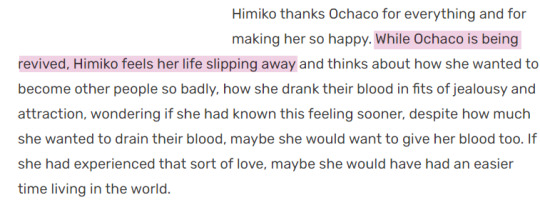











#mha critical#bnha critical#mha spoilers#toga himiko#ochako uraraka#by plot hole moment i mean that by this logic Toga has an infinite blood glitch rendering the twice blood conflict null#just make her a universal blood donor#o negative or whatever#this universe has literal superpowers somebody being o negative isn't that crazy#and it would fit togas theme of blood and love#victims of bad writing#i can add more examples but i think the contrast between these two descriptions is very funny
32 notes
·
View notes
Text
What I Love In Writing
Lately, I've seen so many negative posts (including my own) circulating about things not to do in writing, "advice" about which words to avoid, which tropes are most annoying, etc., etc. No wonder writing is often seen as a discouraging avenue to explore. In response, I've decided to make a post about things I personally LOVE to see in other people's writing, things that make me want to read more and more.
Attention to physical details that are less commonly described in stories. Three of my personal favourites are descriptions of hands, necks, and shoulders, which are just as expressive as eyes and other facial features.
When writers stretch a word's known meaning in a way that feels new and off-kilter. It always surprises me and draws me in. I particularly like when a noun is made into an interesting new verb. For example, "His eyes lanterned the dim room." Even though it might not make immediate sense, it can evoke a variety of new readings and emotions based on the context. If the scene calls for it, invent your own vocabulary. Language is yours.
I personally love contrasts between emotional states and settings, like when a character is facing turmoil on a beautifully sunny day, or, alternatively, two characters expressing their love for each other in a place that's falling apart.
How wonderful is it when someone can pull off the present tense elegantly? That sense of immediacy is refreshing.
Lengthy sentences that cascade rhythmically and emotionally to the point that you reach the end of the sentence and think, "Oh my gosh, that was only one amazing sentence!"
I love when characters are raw and real and messy and complicated, when they feel like people I could meet in my everyday life. I love when good characters do bad things and bad characters do good things.
Metaphors and similes, especially ones I've never read before.
I like when ugly or unexpected things are described beautifully. There is a difference between romanticizing something ugly and acknowledging an ugly thing's attributes thoughtfully enough to illustrate it with the same care and passion as a universally accepted lovely thing.
Personally, and I've changed my mind on this one recently, but I think it's sweet when I can pick up on favourite words or phrases the author likes to return to now and again. I understand it can be repetitive at points, but it's also like discovering a secret, cherished thing I can share with the writer. It adds to the voice. (Side advice: give yourself the liberty to change your opinions and try again with writing techniques you previously disliked).
Emotion, emotion, emotion. I'm an emotional person, and I like emotional writing that always walks that line between "balanced" and "too much." Not necessarily in that everything feels exaggerated or out of proportion with the plot, but that I can sense the characters' emotional states at all times, and sometimes even the grammar or language can reflect that - shorter phrases for an abrupt feeling, elongated ones for drawn-out, languid moments. The world is gorgeous, and our feelings are gorgeous. Writing that can capture that sensitivity has an everlasting effect on me. Like I'm at a party and the lights are too bright, the music is too loud, there are too many people, but it's all a reminder that I'm a human being. We're alive.
There are many, many more aspects of writing I love, too many for me to name but these are just some of the first that came to my mind. Amid all the cautionary writing tips you read out there, I encourage you also to establish for yourself the good things you should do. The risk of perpetual don'ts is a perpetual blank page.
Do what you love, and love what you do, but above all else, do.
#writeblr#writing community#writing#writers on tumblr#text post#writers#for writers#writing advice#kestal post#positivity#encouragement
15 notes
·
View notes
Text
One of my favorite things about MLQC is the frequent use of symbolic imagery and motifs to set scenes and center characters. I think it’s incredibly clever, considering the importance of MC’s dreams, that the dreamlike symbolism is present throughout the story. At times, in MC’s confusion of piecing events together, reading the story almost feels like a sort of dream or vision interpretation. I love how consistent these symbols are for the characters and the way conflicting or contrasting imagery is used to add depth throughout the story. Also, since the story is told through MC’s perspective, the use of imagery shows us that her perception of the world is colored by her care for the main cast. When she’s with Gavin, MC notices fluttering leaves, when she’s with Victor, time slows, when she’s with Kiro, the sun is brighter, and when she’s with Lucien, she’s more attentive to light and shadow.
Under the cut, I have written more (1400ish words more) about symbolism in MLQC and how it adds depth to Lucien's characterization in particular.
Aside from adding to the mood of the story, the symbolism can also be used to narrative effect, showing us how MC is interpreting a character’s actions or motivations.
For example, we can look at how MC sorts through her feelings about Kiro/Helios in Chapter 29. Sun imagery pervaded previous chapters that centered Kiro while moon imagery is associated with Helios. In CH29, MC uses the harmony between the sun and moon as a metaphor when she accepts that Kiro and Helios are one and the same. This adds depth to what MC is feeling about Helios and also serves to contextualize the relationship between the two identities. (Note: I just love the idea that Helios has the same “sunshine” as Kiro but that he reflects it in a subtle way rather than being overwhelmingly positive like Kiro. This dynamic is only ever implied by the imagery and symbolism but it’s so perfect.)
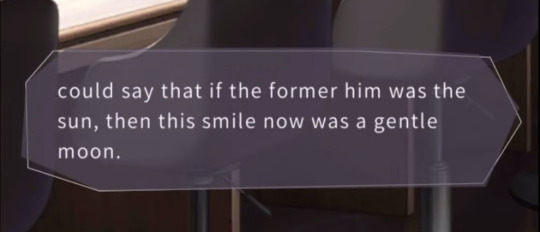
In particular, though, I want to talk about some of the symbolism associated with Lucien and what we can learn from the way these symbols interact with one another.
Light and Shadow
One motif that is very present when the story is focused on Lucien is the balance between light and shadow. (Note: It’s very on the nose at times but executed well, I think, so I’ll give them a pass.) This motif is introduced far before Lucien’s betrayal is ever revealed, as early as his first meeting with MC. (Note: I literally wasn’t sure when the motif was first introduced but I went back to Lucien’s first scene and SURE ENOUGH, there it is. I love how consistent the writing is in this regard. The motifs are handled so well and so intentionally.)

During Lucien’s first scene in the game, light shining in from the window obscures his face. Far ahead of the betrayal, light and shadow are symbolically playing at obscuring his identity from MC. The light/shadow motif is used at first to symbolize Lucien being duplicitous, without much hinting toward his internal struggle. Later, when it’s clear that Lucien is struggling with a choice between metaphorical “dark” desire to continue his mission and “light” of protecting MC, light is used to hint at that internal conflict. An example of this is below, from Lucien's first standoff with Victor in Chapter 11.

Notably, though, sometimes, the “light” represents MC directly while the “shadow” represents Lucien. After Lucien’s internal conflict and desire to protect MC is first touched on in Chapter 16, the two are symbolically juxtaposed by scene-settings back-to-back in the last two units of CH16. 16-24 opens with a description of Lucien’s dark, gloomy room and 16-25 opens with a description of the lamp on MC’s desk casting a bright light. (Note: MC’s Evol is also represented by light often, so I think this imagery for her works even beyond its juxtaposition with Lucien.)


The same thing happens again when MC comes back from the Eternal Winter world, Lucien’s office is described as dark and shadowy when he is alone and then it’s cast in an “ephemeral glow” as soon as MC steps into the room.

Mirrors
A large part of Lucien’s character arc is his failure to properly make sense of his own identity, this struggle is represented by mirrors/reflections. Often, mirrors are shattered or distorted, implying an added difficulty of perception.
Because of the expectations that have been put on him from a young age, Lucien is very disconnected from his own identity. Even with Black Swan set completely aside, because of his savant-like personality and inability to relate to others, Lucien doesn’t view himself as a human being. Beyond that, there is also a struggle between the two identities of “Lucien” and “Ares” implied.
I think that the answer to this struggle is MC understanding Lucien and having clarity about who he is as a person. Light reflected in mirrors represents this concept symbolically in the Mirror Painting date. (Note: I believe this date is only currently available in the CN server, I read this translation) In this date, Lucien and MC paint each other and then use mirrors to reflect light onto the painting when it’s displayed. After being painted and, therefore, symbolically seen by MC, Lucien is finally allowed to turn away from the mirrors and stop worrying about who he is. The mirrors that represent his struggle with identity are able to add depth to a beautiful image when paired with the lights that represent MC’s understanding.

Shattered and Distorted Glass
This goes hand-in-hand with the mirror motif but is worth mentioning on its own because the symbolism is slightly different. While distorted mirrors imply difficulty for Lucien to perceive himself, distorted glass implies a difficulty for others to perceive Lucien. Shattered glass also represents a fractured relationship between the identities of “Lucien” and “Ares” in a few scenes.
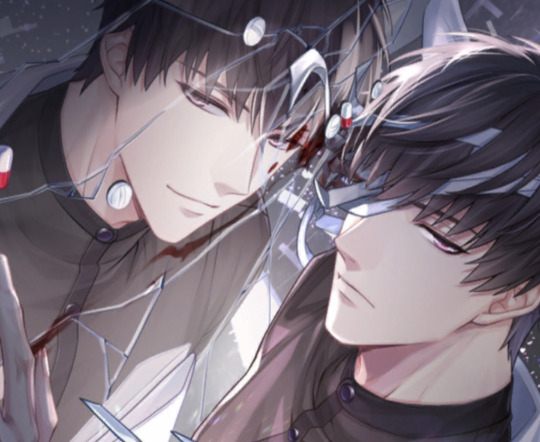
On the wall of the abandoned Ultima Bioresearch Lab, MC finds a quotation written on the wall from the Bible. “For now we see through a glass, darkly. The truth is projected into the hearts of men through a glass lens. It’s distorted, blurry, and one-dimensional.” (Note: I’m assuming that this verse was translated from the Chinese dialogue and not transcribed from an English Bible translation, because this is, at the very least, not a popular translation of the verse that I’m familiar with. Ironically, it’s more popular to translate “glass” here as “mirror” so there goes this whole section LMAO.)
Because of the way it’s presented, I think that this image of distorted glass represents not how MC actually perceives Lucien but, rather, how Lucien believes he perceives her. Obviously, this is also foreshadowing the betrayal so, in a way, he’s correct in asserting that she is not seeing all of him. But, on the whole, this distorted glass imagery is delivered in a way that implies the distortion more as an insecurity on Lucien’s part rather than the reality of MC’s vision.
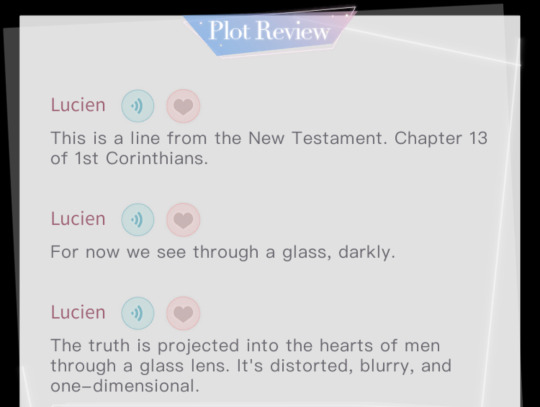
Rainbows
Keeping with Lucien’s themes of paradox and duplicity, one of his main motifs is the appearance of rainbows, despite the fact that he is colorblind. This is, again, representative of MC’s “light” being transformative to Lucien because the rainbows appear when they are together. I think that, rather than being a symbol for Lucien alone, rainbows represent Lucien’s relationship with MC. It’s a sort of combination of MC’s light imagery and Lucien’s refraction/distortion imagery. In the right circumstances, they can create something beautiful together.
It’s also implied throughout the story that Lucien is able to see colors when he’s around MC, so he is truly only able to appreciate the beauty of rainbows when he is with her. (Note: It’s unclear how this works but I think that it’s a side-effect of his Evol mimicking hers. There’s a footage mission where it seems like Lucien has to ask MC to look at something before he can tell the color of it so I think that he is somehow able to see the world through her perspective, possibly by using her Evol to have real-time visions. Does this make sense? Who knows, but I refuse to accept it just as soulmate magic!!!!)
If you haven’t, I highly recommend reading Lucien’s “Rainbow Luck” R&S. (Note: A recording is available here!) In this story, told from the perspective of Lucien’s pen, Iridescent, MC and Lucien see a rainbow together and it’s implied that this is Lucien’s first time being able to see a rainbow because MC is there. (Note: Iridescent as a name itself is an instance of Lucien’s rainbow motif.)

(Note: Lucien's Moments also features a rainbow paperweight at Bond Level 40.)
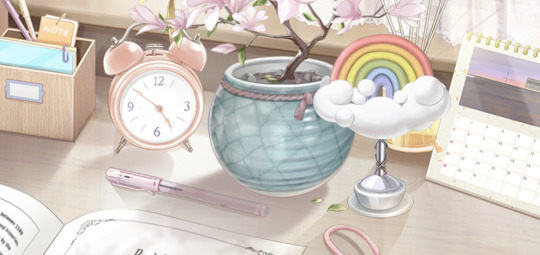
TLDR: Imagery and symbolism are used in MLQC to imply things about the characters and their relationships with MC. In particular, with Lucien, recurring imagery is used to represent his internal conflict and his desire for love and understanding from MC. The symbolism of light and its reflection/refraction is used to great effect throughout Lucien’s story, implying a complex web of internal struggles.
#i'm so normal i'm so normal i'm so normal#lucien is literally colorblind unless he's with MC why DON'T WE TALK ABOUT THAT MORE#606.txt#mlqc#lovepro#love and producer#mr love#mr love queen's choice#mr love dream date#mldd#evol x love#mlqc analysis#lucien#lucien mlqc#lucien mr love#xu mo#xumo#xu shimon#lucien xu#kiro mlqc#gavin mlqc#victor mlqc#mr love analysis
49 notes
·
View notes
Note
Hey, Sophie. I thought I remembered you having a tutorial on how to make a plural AI. I was going to try to make Moon Knight, but I don't know where to start.
I don't have a tutorial, but I essentially just treated Anna and Galladin like two separate characters in the greeting and description.

I wrote their example texts using a similar format, including some banter between the two:

I gave them each their own unique behaviors to draw a clear contrast between them. I like Gally being very strong and confident to a point bordering on arrogance to contrast Anna's low self-esteem. Another thing I wanted was to add points of potential conflict between the two, which is why I included this exchange where they each tell what they dislike about each other.

Here is another example of banter between the two in the definition:

I also needed to toss in this because Anna kept thinking she was a tulpa:

This was my first bot and there are a lot of ways to improve it. But I'm more than satisfied with how Anna and Galladin came out!
I'm interested in figuring out a way to add switching functionality where you're talking a character in one body and the AI can switch the fronter throughout the conversation, but I'm not sure how to do that yet.
The best thing you can do is to just play around and figure out what works and what doesn't. Good luck with your Moon Knight! I'd love to see what you come up with! 😁
#character ai#character.ai#chatbots#chatbot#ai#artificial intelligence#plural#plurality#endogenic#plural system#multiplicity#endogenic system#systems#ai chatbot#system stuff#beta character ai#beta.character.ai#bots#bot#chat bot
10 notes
·
View notes
Text
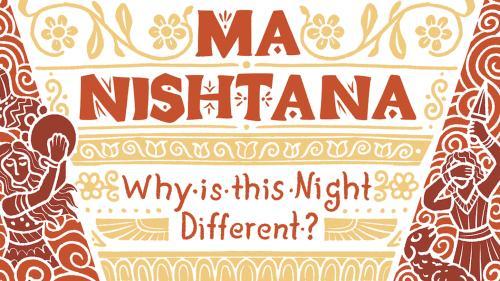
Retellings: Great RPG Mechanics #RPGMechanics: Week Six
I’ve taken an extra week with this one, trying to figure out how to approach this. RPG have always been about telling stories. There’s an interesting bit in Jon Peterson’s Playing at the World talking about the months in 1974 after TSR launched D&D and the disconnect between it being written as a war game– a rules set for medieval fantasy at a certain scale and how it actually got pitched. Very quickly Gygax & Arneson realized that the real pull in advertising was to present stories and suggest players could create their own. That became the key draw of role-playing.
At the same time the idea of “retelling” has been a little less evolved. On the one hand we’ve had licensed rpgs which aim to place players within a specific, existing story– not just a setting– and have them play out their version. The most notorious example I can think of that is Mayfair’s AD&D module for The Keep, the surreal Michael Mann horror movie set during WW2. That has you as fantasy adventurers dropped into the movie’s plot directly.
Other games have played with the idea of tellings and corrections. For example InTERRORgation contrasted, Rashamon style, several testimonies by the PCs about an incident. There’s also The Extraordinary Adventures of Baron Munchausen which revels in lying and contradictions. So we have two senses of retelling: an exploration of a previous story and the act of stopping and correcting in mid-story (done either by ourselves or another).
Ma Nishtana: Why is this Night Different does both of these things. Subtitled “A Passover Storytelling Game,” playing this remains one of my all time favorite storygame experiences. Gabrielle Rabinowitz and Ben Bisogno did an amazing job with this. It’s a beautifully crafted games, so I fear my description isn’t going to do it justice.
The game draws on the tradition of the Passover Seder, the ideas of sharing, involvement, ritual, and storytelling. As the designer say it is not a replacement for that, but a way to echo those aspects. Each player takes up one of the six possible characters– Miriam, Moses, Zipporah, Aaron, Bityah, and the Pharaoh. They then place through a set of ritual steps of play– with a physical ritual, reading, and then roleplaying– to tell another version of the story of Exodus, unpacking what the story means and how it sustains across multiple versions.
I’m not Jewish, but playing this made me feel welcomed into the stories and feelings. It offered a kind, accepting, and vibrant entry point. There’s a lot to be said about the physical ritual component of this– it is striking and works, even online. But I want to focus on the concept of story and retelling.
The game includes safety and collaboration as an organic moment in play. At any point when someone is narrating, another player can say “Wait Wait Wait!” to pause the moment. They can then ask a question for clarification & expansion or they can make a suggestion. This can add new elements or it can be used to revise material. This approach giving the feeling of friends and family gathered together, with the gentle butting in and interruptions that create a sense of camaraderie rather than conflict. I love this idea of playful collaboration between players.
But the other sense of retelling lies in the broader concept: the retelling of a story with cultural weight and importance. The formal structure here points us back to the themes of the Passover story, but each retelling– with different characters and players– may show us new things about those themes. I wonder what other kinds of stories, echoing important cultural content but perhaps at more of a distance might be explored? What would Gilgamesh or Beowulf look like in that context?
What Ma Nishtana does is create engagement with a cultural history, allowing for a new and novel understanding and unpacking the stories and concepts. That’s why it's a dynamite game everyone should read.
To swing this to other rpgs, there’s a parallel here with HeroQuests from Glorantha and Runequest. These quests are in-game enactments of the myths and stories of the player character’s culture. Heroes gather together, supported by the energy and will of a community, to work through a particular tale. They ascend to the Heroplane for this tale– there they face challenges and act out the stories. The power of the stories worked through in the Heroplane can then have an impact on the real world when they return: bringing prophecy, restoring crop fertility, empowering a relic. It depends on the story.
But the story isn’t always the same. The basic concepts exist, but they may be told in different ways. Failure in overcoming challenges can have a negative effect on the real world. But, like Ma Nishtana, the choice of different characters being played and how they react will change things. Heroquests have always been a part of Glorantha’s setting– with different kinds of HQ rules to simulate them: some abstract and some highly mechanical. I love this as another approach to collaboratively building new stories– the telling of which actually impact the game world.
0 notes
Text
Jewish author writing about antisemitism; should I include racism too?
anonymous asked:
Hi! I'm a white Jewish person who's writing a story set in a fantasy world with a Jewish-coded culture. It's important to me to explore antisemitism in this distanced setting, and explore what the Jewish diaspora means to me. I have a lot of people of color in my story as well. I don't know whether I, as a white person, should include racism in a story if it isn't necessary, but I also don't want to erase the aspects of many mildly/moderately assimilated cultures that are affected by racism, and I also don't want to imply somehow that antisemitism is a more serious issue than racism, which is obviously not the case. I was thinking that bigotry might be more culture-based rather than ethnically or racially based, but again, I'm not sure how or whether to write about bigotry against cultures + groups based on cultures + groups that I'm not a part of, and people of color in the story would obviously have their own cultural elements. Is acknowledging bigotry necessary?
It's okay to focus on antisemitism
Other mods have important advice on what exactly might be helpful or applicable to include in your story and how. I want to take a moment with the anxiety you express that focusing on antisemitism and not talking about other types of xenophobia will imply to your readers that you think antisemitism is “more serious” than other forms of bigotry. I hear and honor that anxiety, especially since “Jews only care about Jews” is a stereotype that never seems to go away, so I’m going to say something revolutionary:
It’s okay to center Jews in a story about antisemitism.
There, I said it. But I’m not making the case that you shouldn’t include references to or depictions of other types of bigotry in your story. There are a lot of great reasons why you should, because of what it can do for the complexity of your characters, the depth of your worldbuilding, or the strength of your message about the nature of xenophobia, diaspora, etc.
- How your non-Jewish-coded characters react to the things they experience can affect whether they sympathize over or contribute to the antisemitism at the heart of your story.
- How other types of xenophobia do and don’t manifest in your world can help explain why your world has antisemitism in the first place, and what antisemitism consists of in a world that also contains other minorities outside of the fantasy mainstream culture.
- Including other real-world xenophobia can help you set your antisemitism in context and contrast to help explain what you want to say about it.
Both your story and your message might be strengthened by adding these details. But if you feel the structure of your story doesn’t have room for you to show other characters’ experiences and you’re only considering doing it because you’re afraid you’ll be upholding a negative stereotype of yourself if you don’t, then it might help to realize that if someone is already thinking that, nothing you do is going to change their mind. You can explore antisemitism in your story, but you don’t have the power to solve it, and since you don’t have that power you also don’t have that responsibility. I think adding more facets to your story has the potential to make it great, but leaving it out doesn’t make you evil.
- Meir
Portraying xenophobia
As someone living in Korea and therefore usually on the outside looking in, I feel that a lot of people in Western countries tend to conflate racism and xenophobia. Which does make sense since bigots tend to not exactly care about differences between the two but simply act prejudiced against the “other”. Sci also makes a point below about racialized xenophobia. I feel these are factors contributing to your confusion regarding issues of bigotry in your story.
Xenophobia, as defined by Dictionary.com, is “an aversion or hostility to, disdain for, or fear of foreigners, people from different cultures, or strangers”. You mention “thinking that bigotry might be more culture-based”, and this description fits xenophobia better than most other forms of bigotry. Xenophobia can be seen as an umbrella term including antisemitism, so you are technically including one form of xenophobia through your exploration of antisemitism.
I understand your wariness of writing racism when it doesn’t add to the plot, especially as a white writer. Your concerns that you might “erase the aspects of many mildly/moderately assimilated cultures that are affected by racism” is valid and in fact accurate, since exclusion of racism will of course lead to lack of portrayals of the intersections between racism and xenophobia. I want to reassure you that this is not a bad thing, just a choice you can make. No one story (or at least, no story that can fit into one book) can include all the different forms of oppression in the world. Focusing on one particular form of oppression, particularly one you have personal experience with, is a valid and important form of representation.
You also comment that you “don't want to imply somehow that antisemitism is a more serious issue than racism”, but I honestly feel that doesn’t need too much concern. Much like how queerness and disability are two separate issues with intersections, racism and xenophobia form a Venn diagram, with large intersections but neither completely including the other. A story focusing on autistic characters that doesn’t also have queer rep doesn’t imply queer issues are less serious. Likewise, a story focusing on antisemitism doesn’t imply racism is less serious.
I am slightly more concerned that there might be an accidental implication of antisemitism being a more serious issue compared to other forms of xenophobia. Of course, exploring antisemitism alone is completely valid representation, and there’s no need to go out of your way to try and portray other forms of xenophobia. A microaggression or two, or maybe a mutual bitch out session with a gentile but marginalized friend should be enough to show that antisemitism isn’t more (or less) serious compared to other forms of xenophobia.
-Rune
Avoiding racialized xenophobia
I think one thing you have to be careful with here is racialized xenophobia. Are your characters of color getting disproportionately more xenophobia than your white characters? You might be falling into the trap of racialized xenophobia, which falls under racism, which you want to avoid. An example would be “all Chinese scientists are untrustworthy, but not you, you’re one of the ‘good ones.’” Although this is technically xenophobia, it is also racism.
--Mod Sci
In the case you choose to include even small snippets of other forms of xenophobia in your story, attempting to portray xenophobia without the complications of racism can be a difficult process when they often go hand in hand (especially to a Western audience). So here are a couple of suggestions I have of portraying xenophobia without racism.
First and the simplest method is portraying xenophobia between people of the same race. For example, there is definitely xenophobia against Chinese and Japanese people in Korea, but it would be difficult to claim there is a racial component when all of us are East Asian. (Something you might want to be aware of here is intersections with colorism, where even within the same race, lighter skin and other more westernized features are considered more desirable. I suggest looking through our colorism tag for more details)
Another idea is to include microaggressions for specific cultures rather than something more broad. For example, calling Korean food stinky because kimchi has a strong scent is specifically xenophobic against Koreans, while commenting on small eyes can be directed against Asians in general.
Finally, while antisemitism is a form of ethnicity-based xenophobia, it is also a form of religion-based xenophobia. Muslims and Buddhists and Hindus can absolutely be xenophobic against each other with no racism involved. Should you choose this method, particularly if religious xenophobia is only shown in a shorter scene, I suggest you try and avoid portraying any of the above religions as the Bad or Oppressive ones. As a Christian I will unironically tell you that Christianity is a safe choice for a religiously xenophobic character, as we’re far less likely to face backlash compared to any other religion, and inspiration should unfortunately be overflowing in real life.
-Rune
Other forms of ethno-religious oppression
Here is my TCK perspective as someone brought up in diverse environments where there are often other axes of oppression including religion, ethnicity and class:
Racism and xenophobia can definitely be apples to oranges, so creating a universe where racism no longer exists or has never existed seems doable to me. Perhaps in your fantasy world, structures that buttress racism, such as colonization, slavery and imperialism, are not issues. That still won’t stop people from creating “Us versus Them” divisions, and you can certainly make anti-semitism one of the many forms of xenophobia that exists in this your story. Meir has hinted that your reluctance to declaratively show the harm of anti-semitism indicates a level of anxiety around the topic, and, as someone non-Jewish but also not Christian or Muslim, my perspective is as follows: I’ve always viewed anti-semitism as a particularly virulent form of ethno-religious xenophobia, and while it is a unique experience, it is not the only unique experience when it comes to ethno-religious xenophobia. I think because the 3-way interaction between the Abrahamic religions dominates much of Western geopolitics, that can be how it looks, but the world is a big place (See Rune’s comments for specific examples).
To that effect, I recommend prioritizing anti-semitism alongside other non-racialized forms of xenophobia along ideological, cultural and class-based lines for both POC and non-POC characters. Show how these differences can drive those in power to treat other groups poorly. I conclude by encouraging you to slowly trace your logic when depicting xenophobia towards POC characters in particular. Emphasize bigotry along axes of class and ideology, rather than traits linked to assumed biologically intrinsic features. Ultimately, I think recognizing commonalities between forms of ethno-religious oppression as a whole will help make you more comfortable in depicting anti-semitism with the seriousness it deserves without feeling as though you are trivializing the experiences of other groups.
- Marika
Worldbuilding ethnically and racially diverse cultures
As has been mentioned by other mods, I think it’s completely fine to focus your story on antisemitism and not portray other forms of bigotry if that’s the focus and scope of the story you want to tell. My fellow mods have also offered several valuable suggestions for writing about “culture-based bigotry” in general if that’s what you want to do, while making sure it’s not coming off as racially based. One element I can add is that from a worldbuilding standpoint, it will also help to have your fantasy cultural groups be ethnically and racially diverse. After all, this was common historically in several parts of the world, and depending on which cultures you’re basing your coding on, you could absolutely have fantasy cultures in your world that include characters we would read (according to our modern-day standards) as white, and others that we would read as people of color, within the same fantasy culture. All these characters would face the same culture-based bigotry (such as xenophobia or religious oppression), even though they are read by a modern audience as different races.
As a note, the reason I say “read as” and “according to our modern-day standards” is that the entire concept of whiteness as we know it is very specific to our current cultural context. Who is and isn’t considered white has changed quite a lot over time, and is still the subject of debate today in some cases. Your work will be read by a modern audience, so of course, you need to take into account our current understanding of race and the dynamics surrounding it. However, it’s also helpful to remember that our modern racial categories are fairly new in the context of the many millennia of history of humankind, and that they are certainly not inevitable. Don’t fall into the trap of thinking a fantasy culture has to align itself entirely with modern-day racial categories.
- Niki
385 notes
·
View notes
Text
Alex Fierro's Introduction Full Breakdown
Okokok so. This is going to go full English-professor mode, where I'm drawing conclusions that are gonna seem a little far-fetched. That's what's fun about media analysis! I can say something is a symbol, and even if I don't have enough faith in RR's competency to know if he meant for it to be a symbol, it's still true! That being said, a lot of these choices I'm sure are intentional, either at a literal or subliminal level. Page numbers are going to be used not to assert a kind of authority or whatever— this is a Tumblr post, not an essay— but to help readers find the pages I'm referencing in case they'd like to do some digging of their own. Also, this is going to be really long. Really sorry to anyone with ADHD; I might make an audiofile of this so you can get the information without having to read the whole thing. With all that, let's get into it!
To kick off, let's talk about Alex being in the form of a cheetah when she first meets Magnus. Of course, there's the obvious impact of him seeing her but only so breifly, as well as introducing the conflict between her and the rest of Hall 19. But that could have easily been accomplished by almost any animal. The choice of a cheetah being implicated implies two qualities of Alex that will be recurrent throughout the two books she's in: 1. She has a tendency to run away, as we'll later learn when she describes how she became homeless, and 2. To Magnus, she's elusive. She can't be caught or held down. The event that shows this so transparently is how Alex refuses to define their relationship at the end of the series, despite it clearly surpassing the normal bounds of friendship.
But the cheetah isn't the animal Alex is in the form of when Magnus first gets a good look at her; she's a weasel. Weasel's bring up all kinds of connotations: ferocity, slickness, a lack of charm. When we want to describe someone as an untrustworthy person, we call them a weasel. RR had Alex take this form to play up her comrades' feeling of distrust towards her. She could be a double-crosser. But paradoxically, the up-front and vicious mannerisms of a weasel also have a transperency. She does not try appealing to her Hallmate's sense of goodwill because she doesn't have anything to gain from it. So even though there is the implication that she might be an antagonist, there's also evidence from her actions and mannerisms that she isn't. The weasel's long and skinny frame also allow for a smooth transition into Alex's actual body, which is convenient.
As Alex transforms into her usual human form, Magnus describes her as "a regular human teen, long and lanky, with a swirl of dyed green hair, black at the roots, like a plug of weeds pulled out of a lawn" (pg. 50). That simile at the end is of particular interest. Let's compare it to another time Magnus describes Alex's hair, in Ship of the Dead: "Her hair had started to grow out, the black roots making her look even more imposing, like a lion with a healthy mane" (pg. 136). By contrasting these two different examples, we can see the development of Magnus and Alex's relationship. The first time he sees her, he thinks of her hair as something nasty— note the word choice "weeds." Later on, though, he becomes more affectionate towards her, more complentary. The immedient negative reaction is less his actual impression, though, and more the reaction he expected to have based on everyone else's reaction to Alex.
Her clothes are equally as interesting; as Magnus describes it, Alex wears "battered rose high-tops, skinny lime green corduroy pants, a pink-and-green argyle sweater-vest over a white tee, and another pink cashmere sweather wrapped around the waist like a kilt" (pg. 50). Aside from the obvious fact that this outfit is a) bizzare, b) fire, and c) Alex's signature colors, which add a layer of style to what can otherwise be a somewhat boring series fashion-wise (excuse me, Blitz), the outfit reveals a crucial facet of Alex's backstory in a kind of subtle way. These are expensive clothes, like the Stella McCartney dress in Alex's room. Note the mention of fabrics (corduroy, cashmere) and patterns (argyle). These indicate wealth and status. Even the high-tops; shoes like that don't come cheap. But I'd like to return to the very first word of the section: "battered." Alex's wardrobe show-cases a proximity to wealth, but also shows that that proximity has been strained and lengthened, maybe for an extended period of time. Alex dresses like a rich person, but she isn't one. Least, not anymore.
The last word of that outfit-introduction is also of interest: "kilt." At the current moment, Magnus thinks that Alex is male. No one has indicated otherwise to him. Everyone has been referring to Alex with he/him pronouns. Samirah called Alex her "brother" (pg. 29). His first thought in seeing what he at first perceives as a guy with a jacket wrapped around the waist is That looks like a kilt. This thought tells us about Magnus: despite being open and accepting, he still has some lingering notions of gender conformity from his years in wider American society.
Magnus also indicates that the outfit "reminded me of a jester's motley, or the coloration of a venomous animal warning the whole world" (pg. 50). This is rather self-explanatory, but it's still worth noting that Magnus sees the outfit as something bizzare, strange, and even perhaps comical. This places Alex at odds with the other people Magnus has met. It also reveals that Magnus has zero fashion sense. But we already knew that.
After finishing up staring at the ensemble, Magnus finally gets around to actually looking Alex in the face. First Magnus says that he "forgot how to breathe" (pg. 50), which, yeah, relatable. This is justifed by saying that Alex has the same face as Loki, but the very same sentence that asserts that that's the case also suggests an alternative reason: Alex has "the same unearthly beauty" as her father. Here we can see the beginnings of Magnus's attraction to Alex, though at this point, he still has a lot of internalized homophobia. Though there's certainly some truth in that Magnus was unnerved by Alex's resemblance to Loki, the idea that Magnus pointed out that Alex was pretty without elaborating on that thought until about a chapter later— after he was informed that Alex was presently a girl— can tell us a lot about how Magnus perceives sex and beauty.
Of course, Alex's eyes are given special attention. She has cool eyes; what can I say? But I'd like to focus in on how Magnus here depicts Alex's heterochromia as "completely unnerving" (pg. 50). Again, let's contrast this with how he describes them after getting to know Alex a little better in Ship of the Dead. In Chapter 3, Magnus describes "[Alex's] dark brown eye and his amber eye like mismatched moons cresting the horizon" (pg. 25). Once again, this shows the development of their relationship— but this time, it's in a much more personal way. Eyes are the windows to the soul; they are culturally important and biologically important in inter-personal connections. In you look into someone's eyes, you're giving them your full attention, and you're implying a kind of closeness. The way that Magnus describes Alex's eyes in the second passage is downright intimate. At this point, he is in love with Alex, and it is clear when contrasting the two descriptions.
As my last point, I'd like to discuss Alex's first words on page: "'Point that rifle somewhere else, or I will wrap it around your neck like a bow tie'" (pg. 51). First of all, Alex saying this with a "perfect white smile" (pg. 51) on his face implies that she is used to being threatened. She is not afraid of being shot; she counters the promise of an attack with a promise of her own. This pleads the question: why is Alex accustomed to violence? What events of her past or qualities of her life have brought her to this point? The threat itself reveals Alex's trauma from being genderfluid in a society with rigid gender norms, as well as her antagonistic relationship with her father. Magnus makes a comment that Alex "might actually know how to tie a bow tie, which was kind scary arcane knowledge" (pg. 51). Like Alex's wardrobe, the idea that she may have experience in high-class fashion also implies her former status as a rich kid.
I could go on. I could break apart Alex saying "'Pleased to meet you all, I guess'" (pg. 51). There is a wealth of information in this short page span that tells us things about Alex Fierro in the present moment, quietly demonstrates things about her past, and characterizes the narrator Magnus Chase. This passage is also effective in hindsight in marking the progress of Magnus and Alex's relationship.
But I'd like to take a step back and look at not the pieces, but the whole picture. Alex Fierro gets a full page of pure description— her outfit, her face— and about a chapter of introduction. This comes after several chapters of build-up. Alex Fierro is an important character you need to keep your eyes on. Alex Fierro is emotionally significant to the main character, Magnus Chase. Alex Fierro is one of the most developed and well-rounded characters that Rick Riordan has ever written— heck, she's one of the best characters in middle-grade books period. The extended emphasis on her and her alone tells us exactly what role she's going to play in this story: she's the star.
#she IS the moment#I'm sure I missed a few things too#alex fierro#mcga#magnus chase#magnus chase and the gods of asgard#fierrochase#magnus chase/alex fierro#mcatgoa
164 notes
·
View notes
Photo

[Image Description: two panels from Chapter twenty two of the Pokemon Special Sword and Shield arc. The first panel has Piers off-screen calling out to Raihan who is rounding the corner with the nickname “Rai-Rai”. The second panel has Piers casually sitting on a crate waving to Raihan who is offscreen and smiling. Piers in this panel says “over here”] I have to say outside of Hop likely not getting to be a hero of Galar in Pokespe and Marvin’s irrelevant self, I’m really loving everything that has been added to SwSh story. Chapter 22 is honestly a shining example of this. To start off again seeing that the royal twins Sordward and Shieldbert are being given some actual relevance is a nice use of their characters. They come off far more threatening here than they did in the games. Plus I really felt for Schilly and how concerned she was about her team’s welfare and how she’s desperate to find the last remaining members. And then Sonia also picking up on a lead relating to the two...this is honestly what should’ve happened in the games. But then the real drama happens when Sonia’s taxicab is attacked knocking both her and the driver out. At some point Leon finds her and brings her to the nearest town Spikemuth for help where he runs into Piers and Raihan. I loved how Piers mentioned the medical care is better established in Hammerlocke than Spikemuth, as it adds to the worldbuilding and shows how dilapidated Spikemuth truly is. Plus with the revelation that Sonia ran out on Leon from earlier chapters, Leon saving her and bringing her to safety will likely open up the potential for a much needed talk between the two. I already love Pokespe’s version of Raihan being more involved in things and showing off his intellectual nature (that’s shown in games but not explored in full detail). Plus I love that he and Piers have an established relationship here rather than what happens in the games where it seems like Raihan and Piers had barely interacted until the random dynamaxing. Speaking of Piers, it was really nice to see that my whole “Piers didn’t send out Team Yell, they pretty much mutinied because they think he’s a crappy gym leader” thing be confirmed. Once again poor piers and team yell can once again kiss my ass. We also get a chance to see his depression referenced by another character as Raihan mentions that Piers actually would’ve told his gym trainers off. #GivePiersAHug
Also can I just say that Piers giving Raihan and Sonia nicknames because he’s close to them is just so adorable (especially in contrast to Leon who he is shown to not have much of a relationship with at all). Now I want to know if he has a nickname for Marnie. And am I going to use this info to make him give nicknames to my OC in my Pokeverse? Absolutely.
I really like how they shed some light onto the conflict between Piers and Chairman Rose, one of the many things that was neglected in games. Here we see that Piers reject Rose’s offer but that Rose was a good sport about it. And that Piers still respects Rose’s “get things done now” attitude even if he doesn’t particularly care for him (and it seems that the reverse is true in that Rose still respects Piers even if they disagree)
Speaking of Rose (even though he wasn’t visibly in this chapter), I have to say this is so far the best handling of his character yet. The conversation about him between Raihan and Piers about how Opal reached out to that Rose was acting rather out of character with how he handled Bede. Just learning from them about the efforts he made to make things better for the gym challenge like adding daycares, protecting trainers from slander (although I must wonder if he was too late to help Sonia with what happened to her), and making it so that less fortunate children got a chance to compete. Again all great ways to show us how philanthropic he is rather than the barebones we get about him from the games proper. Probably one of my favorite parts of the conversation between Raihan and Piers is how Piers references Lysandre and how he went from philanthropic to not and wondering if the same thing is happening to Rose All in all this was a phenomenal chapter and I’m excited to see how the Pokespe version of SwSh events will unfold
#pokespe#champion leon#gym leader piers#gym leader opal#gym leader raihan#schilly#soudo#sonia#sordward and shieldbert#chairman rose#character analysis
89 notes
·
View notes
Text
5 Tips for Finishing Your Novel
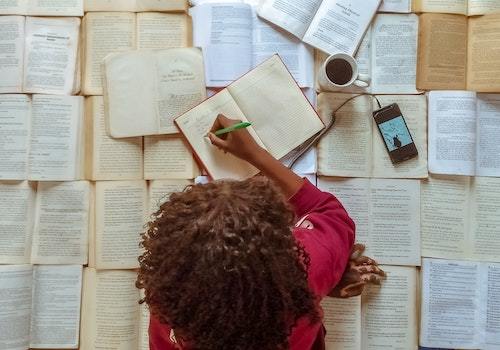
April’s session of Camp NaNoWriMo is drawing to a close, and you might find yourself nearing the end of your novel. If you need some tips on writing and polishing the ending of your story, author Derek Murphy is here to share a few! Plus, you can check out the rest of our novel-finishing resources on our #NaNoFinMo page.
You won NaNoWriMo and have a 50k collection of scenes and sentences, but how do you clean it up and get it done? How do you make sure it’s finished, satisfying and enjoyable? Here are 5 powerful strategies for finishing your novel and some helpful writing tips that will push you past the finish line.
1. Give it a satisfying resolution.
In order to have a powerful story, your book should probably focus on a main character’s change or transformation. There’s an inner war, a.k.a. the character’s emotional healing, and an outer war: the conflict that forced the reckoning. If it’s a purely symbolic internal realization, you can mirror that with actual conflict in the real scene: the breaking of a dish, a fit of rage, a sudden ray of sunlight (or a storm… this should not be pleasant; It’s a breaking point and spiritual death/rebirth).
You can clarify the moment of change by setting up an illustrative contrast, a before and after, that shows how those internal changes have resulted in real-world consequences or benefits. Each character’s unique challenge will match their personal weakness or fear. The price for victory is the one thing they have so far refused to do, or something they cannot give up or bear to lose.
Make sure your protagonist has gone through a transformative struggle to arrive at deep insights, knowledge or awareness. Find a way to deepen the incidental scenes so that they become instrumental to a deeper purpose, leading towards an identity-shifting event.
The plot is what happens, and it’s important. But you can make it more dramatic and meaningful by making sure you demonstrate how hard it was and what it cost. It matters, it is remarkable, because it forced your protagonist to change.
Your conclusion might include:
Physical tension as allies perform a tug-of-war battle against resistance, that shows how difficult this struggle is, and how much force is required.
The consideration phase, as characters are tempted last minute or the price for victory is revealed: the sweet memories that give them awareness that this fight is worth the cost or risk (you need to show them making the choice, knowing what they will lose).
The final flashback, as the full backstory is revealed so we can see exactly why this conflict is so difficult or meaningful for the main character.
2. Add (unresolved) conflict.
Your story is made up of the events and scenes, where something happens. Each new event will push the characters further into the plot. Slow scenes where nothing is really happening can be red flags, so the first thing to focus on is increasing conflict, drama, suspense and intrigue. This is what creates urgency. The full reveal, demonstrating why THIS challenge is so difficult and powerful, should happen just before the final battle or resolution.
You want to make sure every scene, especially in your conclusion, has enough conflict. I recommend these three:
Outer Conflict (threats): Challenges or obstacles that prevent the character from achieving goals.
Inner Conflict (doubts): Moral struggles, decisions, guilt or shame, anger.
Friendly Fire (betrayal): Strong disagreements between allies or supporting characters.
You want to extend and deepen the potential conflict, without resolving it too easily. The biggest destroyer of conflict is conversation: when your characters just sit around and talk to each other. Most conflict involves a lack of information, and a desire for clarity. A lot of conflict is perceived or imagined.
The most important information needs to come last, and come at a great price. The information that has an emotional impact, and influences their actions and decisions, should be big reveals at dramatic peaks. A surprise or twist should be treated as an event: each scene is leading towards a change or new piece of information that provokes the protagonist to respond.
3. Fill plot holes with character motivation.
After you’ve made sure that “what actually happens” is intriguing (opening questions and raising tensions without resolving them) you can focus on making sure the plot holes are filled, and characters are properly motivated – these two things are usually adjacent.
You can find and fill plot holes by asking:
Why are the characters doing this?
Why does any of it matter?
Basically, readers need to respect the main characters enough to care what happens to them, so their choices and actions need to make sense within the given information. If there’s a simpler, easier solution, readers will get stuck up on “why didn’t they just…”? To fix plot holes and gaps in logic or continuity, or make the story go where you need it to, you can add urgency, fix the mood of the scene (bigger stakes require bigger justifications), show characters in a weakened mental state, or raise concerns but have them dismissed, with an excuse or justification.
You need rational characters to make plausible choices that lead to dire consequences. You need show why they don’t do something easier, or nothing at all, or why they face clear challenges, despite potential obstacles.
They’ll also require a deeper motivation, for why they’re willing to put themselves in identity-destroying conflict, rather than just giving up or running away. Why do they stay in THIS fight, when they’ve run from similar ones? If they weren’t ready at the beginning, why are the ready now – what changed in them, as a result of your story’s journey?
Your protagonist needs to have a strong, consistent internal compass, and it needs to be revealed through incidents that establish their character. This is who they are. Without this reliable core identity, we won’t be able to tell a story that forces them to change.
4. Let readers picture your story with detailed description.
In the final stages of revision, you can begin improving the description with specific details.
It’s smart to start – or end – a chapter with a vivid, immediate scene. You want to leave readers with an image they can see in their minds, hopefully connected to the feeling you aim to evoke. You can close a chapter with a reference back to a motif or image, with a deeper or more reflective context; applying meaning to the metaphor. This will help readers feel engaged, be moved, and leave a lasting impact.
Vivid scenes are mostly a matter of detailed description, so add the specifics about the story environment. Be precise, not vague. Instead of “she put a plate of tea and snacks on the table” you can write “she gently placed an antique porcelain teapot on the table. I could smell it was Earl Grey from the scent of bergamot. The half-sleeve of Oreos and can of onion-flavored Pringles seemed incongruous with the fancy dishes, but I knew she was making an effort to welcome me.”
Focus on the sensations and feelings; but also zero-in on any potential sources of conflict or internal emotions or states of mind. In my example above, the host might be nervous or ashamed of her spread; or perhaps she has a degenerative brain disease and doesn’t notice the incongruity. Tensions are unspoken, potential sources of negative feelings. They hover in the background of your description.
Readers will remember the pictures you put in their heads, not the words on the page.
Description should serve and be bound to the story, not distract from it.
It should be squeezed into and around the scene action, when the protagonist is using or exploring.
Show what’s different, not what’s the same.
Leave space for readers to fill in the gaps, but get them started in the right direction so they aren’t surprised later.
Sidenote: be careful about your metaphors, analogies and similes. Each one will put a picture into readers’ minds, and it can quickly get overcrowded with imagery. You’re asking them to ignore your real scene and think of something else. Use them to confirm and amplify the scene you have, and limit distractions.
5. Prepare to publish.
Typos are bad, but perfectionism will ruin you. This section is about editing and proofreading, but I don’t have time for all that, and you don’t either. The real problem with a story is rarely the number of typos. A very clean book isn’t better if people stop reading.
You can solve a lot of common writing problems, with my big list of 25 common writing mistakes, and self-edit your manuscript to make it as good as possible. After that, a copyeditor or proofreader isn’t always the best investment (and it can also be the biggest publishing cost).
Instead, use an editing software (I like Grammarly) to root out obvious mistakes, but don’t dwell on the small stuff like perfecting every word or rearranging the commas. Spending a very long time wrestling a poorly-written manuscript in shape is less effective than getting something (actually) done to the point where you’re comfortable sharing it.
This may be difficult at first, but you can’t learn and improve without genuine reader feedback (from people who aren’t your mom or best friend; nor the short-sighted opinions of a self-proclaimed literature enthusiast). You need to find readers who enjoy your particular genre, and the sooner you find them, the more valuable feedback you can get.
Shorten the feedback loop: Get over the fear and focus on learning by getting feedback early and often. However, this doesn’t just mean joining a writer’s club: writers are brutal and might focus on trivial things. The safest bet is to make it public, on Wattpad at least. Or get a cheap cover and throw it up on Kindle, Draft2Digital or even your own blog.
Making it public is scary and vulnerable, but it’s better than letting the fear of messing up keep you from the brutal, necessary experience of allowing readers to tell you what they liked and disliked about your writing. Will some people be critical? Yes! But guess what, you’ll get negative reviews even if you’re a brilliant, famous writer. Those are inevitable. And the first negative reviews may teach you more about writing than 10 years attempting to self-edit, afraid of putting your book out into the world.
PS. You can use resources, like my 24-chapter plot outline, as a way to spot story gaps in your manuscript and improve the structure (especially if your book suffers from a “soggy middle.)

Derek Murphy has a PhD in Literature, writes urban fantasy and is the founder of the alliance of young adult authors. More recently, he’s started sharing writing tips on http://www.writethemagic.com
Top photo by Adegbenro Emmanuel Dipo on Unsplash.
#nanowrimo#camp nanowrimo#nanofinmo#writing advice#writing tips#finishing a novel#by nano guest#derek murphy
145 notes
·
View notes
Text
Cataloguing Homestuck’s Art Styles
Hussie deploys a number of distinct art styles throughout Homestuck, each serving different purposes in the narrative. A number of these, especially those mentioned in the published book series’ author commentary, have been catalogued in the Homestuck wiki [1]. These officially named styles are well-known enough to appear in quora answers. However, Homestuck employs a much larger variety of stylistic manipulations than explicitly mentioned in the book commentary or wiki. While scanning through the comic again for this project, I wanted to catalogue the rest of them!
This post constitutes a working list of all distinct art styles present in Homestuck. I’ve chosen not to include the distinct styles of the fanartists/outside artists who contributed to the comic; that will be a project for another day. As far as I know, this list only comprises the different styles Hussie develops throughout the comic. I have tried to bring a degree of specific formal analysis (also known as art-historical language) into my description of each style.
1. “Classic” Style
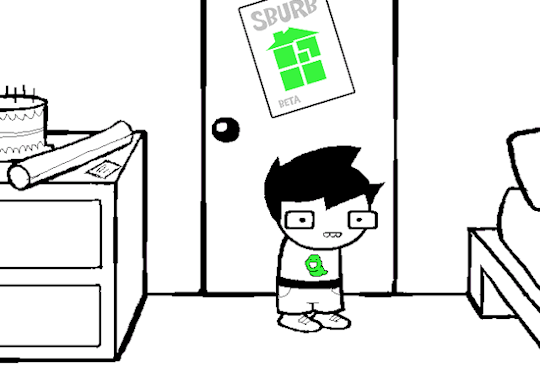
Page 1 of Homestuck

Page 1349 of Homestuck
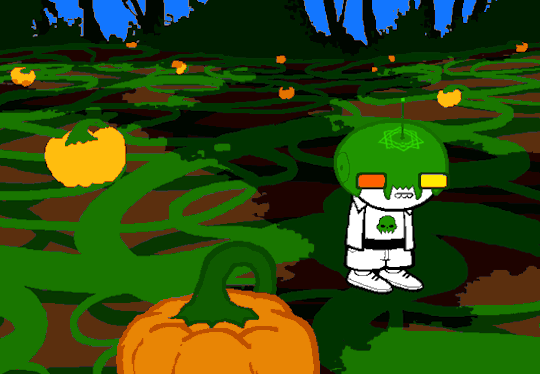
Page 4227 of Homestuck
The “Classic” Homestuck style appears on the first page of the comic. Although not officially described by the wiki, it is widely understood as the comic’s typical graphic norm. Characters have simplified faces and clothes, and they frequently lack arms. Elements are often outlined in a black stroke, especially to differentiate them from other adjacent, similarly-colored elements. In more colorful panels, scenery may be made up of solid blocks with bright colors. Sprites (base character illustrations) and elements are repurposed from panel to panel in new combinations. Homestuck even takes up the repurposing of sprites as a gag, as in page 1349 above where the ability to flip one’s sprite allows Noir to regain his lost wrist barcode.
This style obviously shares characteristics with Hussie’s style in Problem Sleuth. General characteristics that frequently appear in Hussie’s art are present, such as circular faces and rounded edges on quadrilaterals. The Classic Style umbrella actually covers the broadest range of visuals out of any style catalogued here. The uber-simplistic sprites, such as John on page 1, have typically been lumped in with, for example, the illustration on the cover of Homestuck Book 1, or the two other examples I pulled for this post. So, in the Classic Style, characters can sometimes appear with arms, sometimes without, and in outfits of varying detail, but they retain the same facial features and simplistic quality. The circular facial shape is especially characteristic of this style, along with the lack of a neck. The neck-less quality, static poses, and simplistic detail chiefly differentiate some instances of Classic Style from Hero Mode, though there are still some grey areas.
2. Scribble Mode

Page 1931 of Homestuck

Page 1937 of Homestuck
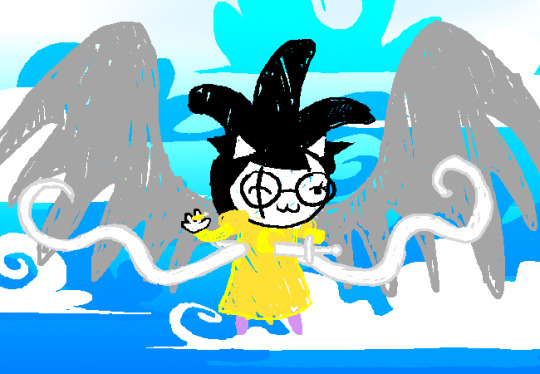
Page 1798 of Homestuck
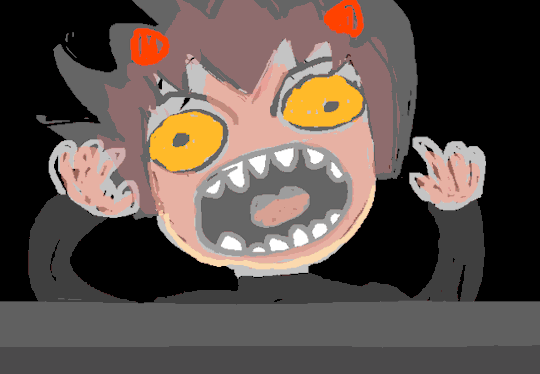
Page 3140 of Homestuck
This style is recognized by the Homestuck wiki, which describes it as emphasizing “a particularly silly/stupid moment in the story, particularly those to be imagined by a character.” That is to say, this style often denotes imagined scenarios which do not actually occur in the comic but instead in a character’s imagination, and especially those which form the butt of jokes. It is also employed simply to highlight silliness. This style is constructed to appear as if the author has “scribbled” rapidly between the outlines of forms to fill in color, creating gaps in those forms. Generally, strokes are made to seem more careless, and less detail is used. While the style is meant to mimic a scribbling motion, it does not always end up crude or parodic. For example, in this “charming vignette” (in Hussie’s words) depicting the Mayor’s dream, the scribble style actually illustrates a remarkably beautiful and almost impressionistic series of panels. Although the dream vignette has certain obvious scribbley elements and certainly depicts an imagined scenario, I would argue that it combines aspects of both Scribble Mode and Hussnasty Mode (#4 in this post) throughout.
I have also identified two distinct styles within the Scribble Mode umbrella. One always uses a thin, apparently single-pixel-wide black line to outline forms, while the other uses a thicker stroke for both its filling and outline. You can see the difference between these in the four examples I’ve pulled; they are sometimes even combined within one single Scribble Mode panel.
3. Hero Mode
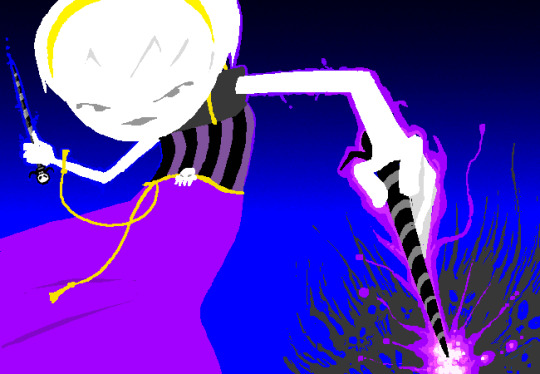
Page 1815 of Homestuck

Page 2063 of Homestuck
Hero Mode was officially named as such by Hussie. The Homestuck wiki page describes it as cropping up to “emphasize a particularly epic moment in the story.” Hussie originally called the style “action panels” before hitting upon the current name, emphasizing the link to action scenes and dynamic poses. Along with dynamic posing, characters are drawn in greater detail and tend to have elongated limbs. Some crossover can be seen between Hero Mode and Hussnasty Mode. I would argue that characters in Hero Mode usually retain the original style’s characteristic lack of a neck, while Hussnasty Mode often adds one. Compared with the Classic style, Hero Mode always adds arms. The degree to which Hero Mode drawings include the “hatching-type effect” characteristic of Hussnasty Mode varies from panel to panel. The difference between Hero Mode and Classic Mode can be observed clearly on these two pages, where Damara shifts between the two styles at the behest of Scratch, who asks her to “render [herself] in a more symbolic manner.”
The wiki asserts that “Hero Mode dispenses with the black outline that typifies sprite-style animation and scribble mode,” but I don’t think it can actually be characterized as the only lineless style. Scribble Mode and Hussnasty Mode also sometimes feature a lineless graphic style depending on which part of a character is being depicted, or the need for a line to differentiate two features of a similar color. A willingness to move between lined and lineless blocks of color characterizes Hussie’s art as a whole.
4. Hussnasty Mode
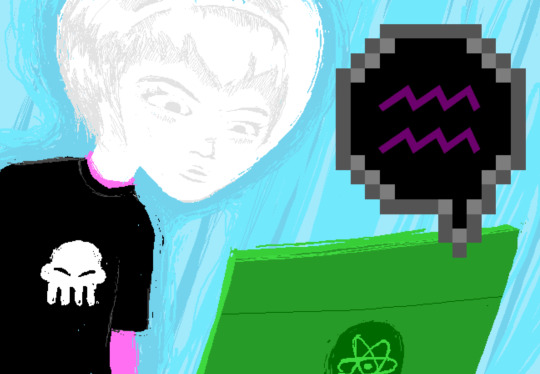
Page 2805 of Homestuck
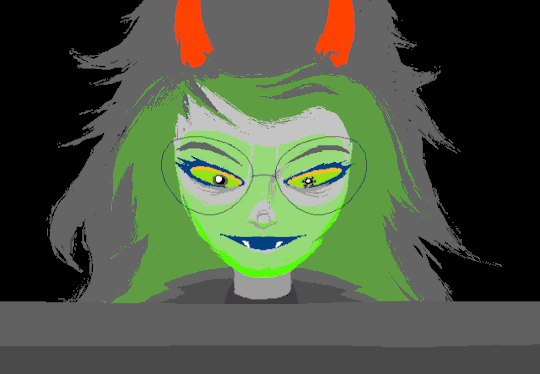
Page 2976 of Homestuck
This art style is also named by the author. In his commentary on page 2805, he writes: “Someone asked me what I called the style, and I replied by naming it "Hussnasty Mode" myself, because well… it's a bit nasty, isn't it? Kind of raw, a little over-illustrated, and making use of a lot of jagged aliased pixel edges for a hatching-type effect. It was sort of the point to make it a little nasty, kind of aggressively incongruous with the other styles previously established.” This quote sums up the style’s characteristics pretty well. Hussie also describes how this style is more naturalistic, or less symbolic, and was meant to work in direct contrast to the extremely symbolic RPG Sprite Mode. He writes that “drawings like this are introduced in contrast with this simple RPG sprite mode, which was also established very recently as something that Homestuck was "allowed" to use as a stylistic presentation of characters and settings… Every time HS does something like this, it's widening its own umbrella in terms of what it's allowed to do stylistically, which includes dramatically simplifying and abstracting its forms. Which implicitly asks another question: Can HS "allow" itself to go in the other direction? To render characters with higher degrees of definition, regardless of congruity, and freely navigate this full artistic palette at any time, resulting in sharp stylistic contrast and a certain amount of visual thrashing? The answer to that question, almost immediately after it's asked in the form of dropping RPG-sprite Rose into a standard panel shot, is yes, HS can do that, and clearly it WILL do that.”
5. RPG Sprite Mode
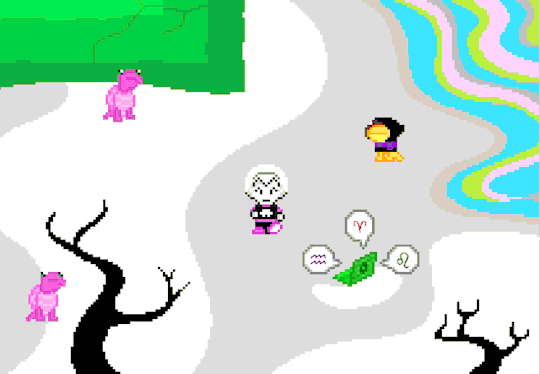
Page 2804 of Homestuck
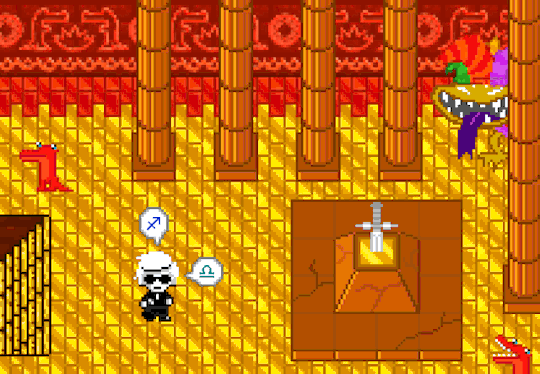
Page 2824 of Homestuck
Despite being officially described by the author, RPG Sprite Mode hasn’t gained much representation as a distinct style (it does not have a wiki page, for example). This style appears after Homestuck’s first walk-around game, now incorporated as a style for static or gif panels. After their joint introduction, this style is juxtaposed against the Hussnasty style. The quotes pulled above in the section on Hussnasty Mode nicely describe the contrast between these two styles and their greater impact on Homestuck’s graphic norms. RPG Sprite Mode always shows characters from an aerial view, mimicking the style of the first walk-around game, which in turn mimics a wealth of RPG sprite games (such as the original Pokemon games). Sprites from these sorts of early games can be characterized by their almost pointillistic use of individual pixels to carefully construct forms.
6. Terezi’s Perspective

Page 2756 of Homestuck
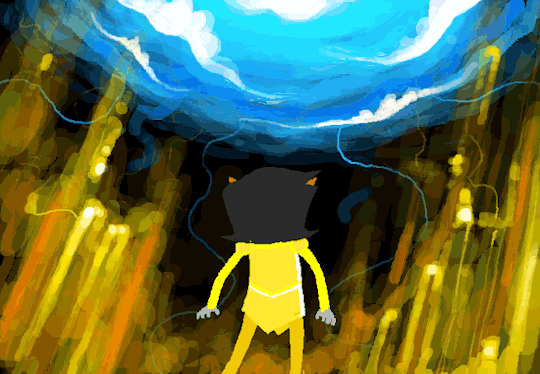
Page 2128 of Homestuck
This style hasn’t been officially described yet. It only crops up as a representation of Terezi’s perspective, conveying some of her experience tasting and smelling colors. While it only appears a few times in the comic, I think it is uniquely visually interesting, and it includes “blurring” techniques which are only rarely employed in the rest of the comic. I’d guess that the effect is created by layering low-opacity strokes over one another and then sliding the different layers’ opacity up and down.
7. SBAHJ Style

Page 8 of Sweet Bro and Hella Jeff
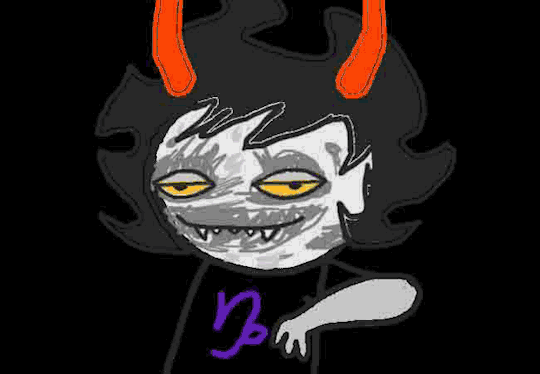
Page 3451 of Homestuck
The SBAHJ comic, featured both within Homestuck and as a spin-off, has its own recognizable style. In the first few pages it has a lot of commonalities with Homestuck’s two versions of Scribble Mode, but later takes on distinct characteristics. It can be characterized in part by its image clipping, an effect where an element is made to look like it has been selected within a square box (in MS Paint or Photoshop) and dragged around the page with little care for the size and accuracy of the selection box. Commenting on page 3451, Hussie describes this effect as follows: “In the SBaHJ comics, one of my cool tactics—which I'm almost positive I invented as a sequential artist—was to elaborately render someone ‘turning around’ by taking one shot of them and gradually altering the pose by crudely rectangle-selecting pieces of their face and nudging them around until they're facing the other way in a totally unconvincing and utterly hideous manner.” Different from Scribble Mode, the SBAHJ style also frequently features blocks of color that appear to be filled with the “paint bucket” tool. When the paint bucket tool is used to fill anti-aliased stokes, it creates a small transparent space between the filling and the original outline, visible in the SBAHJ graphics. Finally, SBAHJ comes to include image compression and glitching, created through “deep frying” compression techniques. Overall, the breadth of manipulative techniques made apparent to the viewer in SBAHJ is much greater than any other style. SBAHJ panels are reproduced wholesale or hyperlinked in Homestuck, but on these two pages Gamzee is also drawn in the SBAHJ style.
8. Caliborn’s Styles

Page 5075 of Homestuck (hyperlinked in pesterlog)
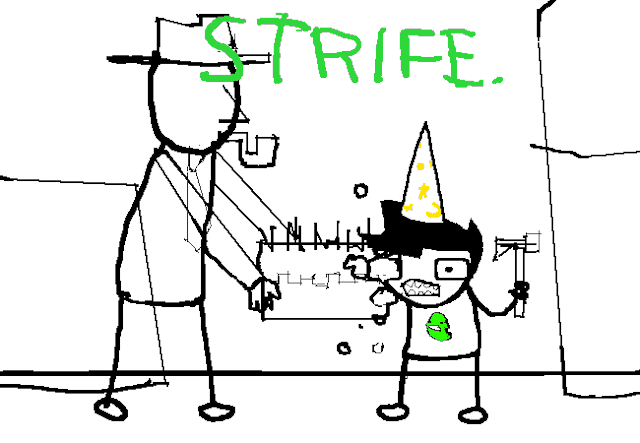
Page 6259 of Homestuck

Page 6929 of Homestuck
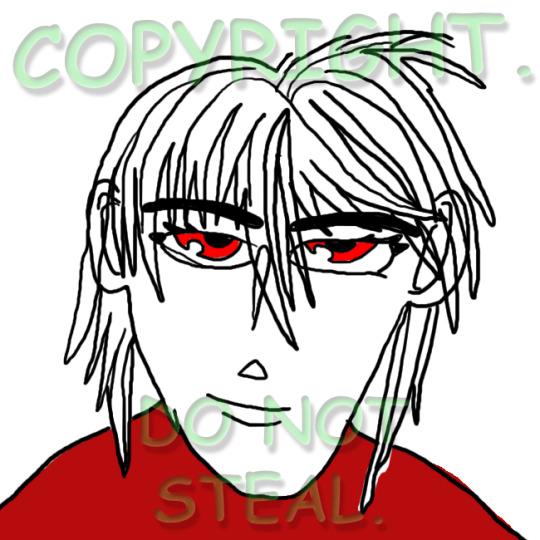
Page 6864 of Homestuck
While Calliope’s in-world art was contributed by Shelby Cragg, Hussie gives Caliborn has three styles of his own. The first is his “angular” style, which Calliope aptly characterizes on page 5109 as containing “inscrutable squiggles” and demonstrating a “penchant for arbitrary, completely baffling straight lines and right angles, almost as if trying unsuccessfully to begin constructing a grid.” The second is the style he uses in Homosuck, which retains elements of his original “baffling right angles” but generally takes on the black outlines characteristic of Homestuck’s Classic style, while employing even cruder detail. Finally, after reading a “How to Draw Manga” book, he develops his “manga” style which uses black strokes, somewhat messy coloring (usually with the paint-bucket tool), and shows an attempt at naturalistic representation despite a complete lack of understanding of human anatomy. This style is specifically meant to emulate manga styles, so it features the characteristic white dots as highlights in the eyes, among other features.
————————————————————————
As becomes apparent through Hussie’s commentary, the different art styles employed in Homestuck do more than just emphasize certain moments; they form part of the comic’s visual language and ask us to question our understanding of graphic representation. The scope of this post also illustrates the attention paid to Homestuck’s visual elements throughout the story’s production and within its readership, even if these visual distinctions have received less attention in scholarship. Despite the variety of styles, we can see Hussie’s characteristic artistic tools, techniques, and sensibilities reflected across the comic.
If you find any styles recurring in the comic that I haven’t mentioned here, feel free to shoot me a message! Again, I haven’t included styles from other contributors; only those developed and drawn by Hussie.
————————————————————————
As we approach the close of the semester, I’ll probably be putting out one more post sometime soon! If you liked this post, you can follow the blog on tumblr for updates or, if you don’t frequent tumblr, sign up for the mailing list to receive an email whenever I publish a new mini-essay!
————————————————————————
[1] These include Hussnasty Mode, Scribble Mode, and Hero Mode.
92 notes
·
View notes
Text
The (Sometimes Unintentional) Subtext of Digital Conversations
Different people have different ideas about what it means to sign an email “XOXO,” what you should use Facebook for, and how long you can wait before texting back.
By
Deborah Tannen
The meanings we glean in conversation are often, maybe mostly, not found in the words spoken, but in how they’re said, and in the spaces between them. Tone of voice, and cadences created by shifts in speed, volume, and pitch, let listeners know whether “Nice job,” is complimentary or sarcastic, or whether “Wow” shows that you’re impressed or underwhelmed. The literal meaning of words is their message, and everything about how words are said is the metamessage. Metamessages communicate how you mean what you say.
More and more conversations are taking place on screens—via texting, Facebook, Instagram, Snapchat, Twitter, email, and myriad other platforms. Some of these written conversations make up for the lack of voicing with conventions that mimic speech, like exclamation points, CAPS, and repetition of words or letters. I can be “so happy!!!!!!!” or “sooooo happy” or “SO happy” or “sosososo happy” or even “SOSOSOSOOOOOO happy!!!!!!!!!!!!!!!” Emoticons, emojis, and gifs help, too. But these visual signals are only the tip of the metamessage iceberg.
Human beings are always in the business of making meaning and interpreting meaning. Because there are options to choose from when sending a message, like which platform to use and how to use it, we see meaning in the choice that was made. But because the technologies, and the conventions for using them, are so new and are changing so fast, even close friends and relatives have differing ideas about how they should be used. And because metamessages are implied rather than stated, they can be misinterpreted or missed entirely.
Different generations are particularly apt to perceive different metamessages in the same words or actions. For example, a Sri Lankan woman living in London told me of hosting her sister and her sister’s teenage daughter. When the girl refused to go out after 3:00 p.m., because that’s when her friends back home got active on WhatsApp, the sisters perceived the metamessage, “I’m not really here. My head and my heart are elsewhere.” But I suspect the girl’s perspective was more like: “I’m here with you—that’s a given—but I also want to stay connected to my friends, and I can’t bear the thought of being left out”
I heard a great range of viewpoints on social media while interviewing over 80 women (ranging in age from 9 to 97) for a study of friendship. And my students at Georgetown University have helped me understand how they manage, and sometimes are tripped up by, the metamessages communicated over social media—and how habits and assumptions can differ.
For instance, when Kate Lucey’s sister had not given birth by her due date, she kept family and friends apprised of what was happening with her pregnancy by posting frequently on Facebook. In response, even distant relatives and casual friends posted well wishes and encouraging thoughts. Kate felt that these postings sent her sister a precious metamessage: Many people love her and care about her pregnancy. The posts strengthened her network of support. Kate was stunned to learn that her roommate perceived a negative metamessage in her sister’s use of Facebook. She said she would have been offended to be kept up to date about a pregnancy that way; she would think, “Geez, why didn’t you call?” Kate’s roommate reasoned that posting on Facebook is so easy that it means nothing. A phone conversation reflects and creates a meaningful relationship, whereas Facebook creates a false sense of intimacy, not a real relationship.
The impression that posting on Facebook is insincere because it’s too easy sounds a lot like the explanation a friend gave me (over email) for disliking “THAT DRAT ‘xoxo,’ which means nothing, just keys to hit.” This perspective–if something is too easy it’s meaningless or insincere—makes sense. Taking time sends a metamessage of caring. Yet I like ‘xoxo’ (or my personal variant, ‘xxoo’), and use it, though only with friends who use it first. I think xoxo fills a need: It’s a more affectionate way to close an email than “Best” but not as fervent as “Love,” which, in any case, some people don’t feel comfortable using with friends, though some do. Maybe it strikes some as fake because it’s a substitution, standing for “love and kisses” but not denoting it. Or maybe it seems too cutesy. Whatever the source of these impressions, deciding how to sign off a message becomes a challenge, since any choice you make will send metamessages that you may not intend or suspect.
I was shocked to realize that my students might be perceiving metamessages opposite from what I intend when I reply to their email requests and queries. One of them pointed out that when he emails professors, he begins with a salutation (“Dear Professor Smith”) and a greeting like “I hope you’re enjoying the weekend.” Only then does he explain his request—in detail—followed by a friendly closing, again about the weekend or the weather, before wrapping up with “Sincerely” or “Yours truly” above his name. (I recognized his description: That’s the way most of my students’ emails look.) The student then complained that many of his professors’ responses omit the salutation, greeting, full explanation, friendly closing, signature, and name. All he receives is a naked reply to his question, and usually a cryptic one at that. I realized that I do this, too–or did, before he, and others in class discussion, opened my eyes. I had assumed that dispensing with those formalities sends a metamessage of casual friendliness, more or less the way I use email with close friends and family. But students regard email as formal, so the omission of those niceties often strikes them as disrespectful, even rude. (Now I go back and add the trimmings before pressing SEND.)
It’s not surprising that professors’ and students’ practices would vary, given the difference in power and age. But even best friends can have very different ideas about appropriate ways to use social media. Noelle Miesfeld and Rachel Jacobson had been close friends since college, and they stayed in close touch after graduation, often having long telephone conversations, catching up. After a number of years, however, they began communicating more through texting. This meant more frequent conversations—often daily or even multiple times a day. So Noelle was surprised when Rachel registered a complaint: She’d been telling Noelle about a problem, and she felt that Noelle’s responses seemed too casual and brief to show real concern. Rachel missed her caring, emotionally supportive friend. They traced the trouble to their contrasting assumptions about texting. To Noelle, comforting closeness resided in the frequency of their exchanges. To Rachel, frequency didn’t substitute for the expression of feeling and detailed discussion of her situation that they’d shared in the past—the kinds of conversations that Noelle didn’t feel could or should take place through texting.
When deciding which platform to use and how to use it, as well as how to interpret communications you receive—or don’t receive—you have to know which platforms your friends tend to use and how they use them. Some will answer texts but not emails. Others don’t check their phones regularly, so you can’t rely on texting to reach them. The proliferation of platforms means more options to exploit but also more opportunities for your messages to be misinterpreted. How quickly does a particular friend usually reply to a text or email? What does the lack of an immediate response mean? So firm is some people’s expectation of a quick reply to a text that any lapse carries meaning. A student, telling me about a friend who, in her words, “stopped talking” to her, said, by way of explanation, “She’d text me back two days later.” To her, a two-day delay was tantamount to not talking at all.
Silence can be a deliberate communication. One woman said of a text she received from a friend, “I was so annoyed, I’m just not responding. I just didn’t answer.” Yet in other cases, silence doesn’t mean anything; it results from circumstances. A young woman thought her boyfriend’s delay in responding meant he was angry at her. It turned out his phone battery had run out.
Perceived metamessages of annoyance can snowball, whether or not they were intended. A student recounted in an interview a Facebook message exchange with a friend that, she felt, should have been straightforward but became complicated. She sent a message suggesting they go running later than planned. The friend messaged back, “I guess that’s okay. Fine, see you then.” That little opener, “I guess,” and the unenthusiastic “okay” seemed to imply that she wasn’t thrilled with the change of plans. So the student responded, “I’m sorry, I didn’t mean to be difficult. I’m more flexible than I made it sound. I can actually just do one o’clock like we planned.” That set off a back-and-forth that went four rounds—“No no no let’s do the time you wanna do,” “No no no let’s do the time we said.” Hair-tearing exchanges like these are particularly common among girls and women because, as the student pointed out, they often worry about coming across as too demanding and hurting others’ feelings.
My student Holly DiClemente explained how her peers make creative use of digital features to avoid hurting friends’ feelings. One example is ghost reading—reading a message without opening it, by just reading the preview in the text app, or on your lock screen. If a phone automatically sends “read receipt” notices to let others know their messages have been opened and, presumably, read, ghost reading comes in handy to manage the implied metamessages. If you see from the text notification that a friend is asking if you want to hang out, and you don’t want to but you don’t want to hurt her feelings, you can open the message later and tell her you’re sorry you just got it. The “read receipts” feature can also be used to show you’re mad; it lets someone know you’ve read their message and are intentionally not responding—a visual virtual snub. But there, too, they might think you’re mad when you’re not. Maybe you saw that the message was long, so you put off replying until you’d have more time to read it, or to write a thoughtful response.
Metamessages—intended or not—can reside in just about any aspect of digital communication, even something as minor and automatic as listing recipients’ names when sending email. If you enter the addresses on the “to” or “cc” line, everyone who receives it can see not only who else is getting the message but also what order you put the names in. Two women I interviewed together, Lucy McBride and Annie Finnell, pointed out some of the resulting metamessages: “You feel special when you’re the first one on there,” Lucy said. Annie agreed: “You do. And you feel not special when you’re the last one.” Lucy added, “Because if you’re dead last, it’s like they were thinking, ‘Who am I forgetting?’” To avoid offending those whose names come later or last, you can put recipients’ email addresses on the “bcc” line. But that sends a metamessage, too. It’s what people do when the list of recipients is very long, so “It looks like you’re inviting all of Northwest Washington!”
Anytime there are multiple recipients, metamessages can get complicated. I was part of a group that used email to confer about a joint project. In one such exchange, a member of our group expressed well wishes to another about a medical condition, after which all the others chimed in, echoing the expressions of concern. I was puzzled. I didn’t know whether this flurry of well wishes was related to the ongoing medical challenge I knew this group member had been experiencing, or whether there had been a new and dangerous development I didn’t know about. I asked another group member, who said she was not aware of any new developments either, but wanted to express her general support for our ailing friend. I went ahead and sent my own well wishes, cc’ing only the one who first expressed concern. But then I worried that the others would think me callous and uncaring. I rather regretted having foregone the option of allowing—or forcing--everyone to overhear my well wishes.
Every word we speak is chock-full of metamessages telling others not only how we mean what we say but also who we are. It has always been that way; it’s the only way language can work to communicate ideas and negotiate relationships. With social media, we have ever more ways to do this—and ever more things to worry about, to make sure the self we’re displaying is the one we believe we are—or the one we want to be.
20 notes
·
View notes
Note
I think with zukka it’s the exact opposite as soulmates like in every way these two should’ve never even met let alone connect but they did and they do and they balance each other out in so many ways... them being together isnt fulfilling some serious destiny them being together is being able to let their guard down and being who they were never allowed to be: youthful, and playful... essentially when I think of zukka I think of laughter and the heaviness one’s heart feels when they’re nearly overwhelmed with happiness. No fate, no destiny, no titles... just being.
i think that in order to break down what sokka and zuko’s relationship means in relation to soulmates especially interpreting this relationship as romantic, we need to start with the basics. get ready for a long and probably pretty wordy ride.
let's start with the meaning of the word “soulmate” specifically in fandom. the most common perception of a soulmate in fandom is that your soulmate is quite literally the other half of your soul, meaning that without this romantic interest you are somehow incomplete. now, what the hell is a soul? according to my dear friend google, a soul is “the spirit or the essence of a person, and the part of the person that makes them who they are and will be even after death.” is it even possible to split a soul in half? well, in my opinion everyone in fandom is essentially insane, so i’d rather say that no, it is not possible for a soulmate to be the other part of your soul, or for another person fictional or otherwise to complete you as another person, fictional or otherwise (when it's fictional, a soulmate can add depth and nuance, maybe?? but not complete. what the fuck does complete even mean). i have a more interesting interpretation of the meaning of a soulmate at hand, specifically because my first language is spanish: the closest thing to the word “soulmate” in spanish is alma gemela, literally “twin soul.” i believe it is much more interesting to interpret a soulmate as a person whose soul is a mirror to yours, or a reflection. a complement. the notion that someone is perfect and made for you romantically is essentially full of shit and a very lazy mindset, but anyway.
if we’re talking about being destined to meet a person, or being different faces of the same coin, or stuff like that, then of course this is a thing in fiction. aang and zuko and katara are definitely soulmates in terms of being destined to meet and change each other in a meaningful and earth-shattering way. the concepts of destiny and fate are not only an actual thing in atla, but also very prominent and loud in themes and narrative, and in the mindsets and beliefs of the characters themselves; it heavily influences their actions and approach to other characters, especially zuko. from his perspective, zuko’s dynamic with aang throughout the show and in general (meaning before and after he joined the gaang) is in part shaped by his sense of morality, and in part by his belief that his destiny is somehow intertwined with aang’s (he was right, of course), similarly to how katara approached aang (too, as a beacon of hope) or even how she saw zuko as a definitive enemy (in contrast to how sokka saw zuko as pretty much a fool and a recurrent inconvenience) aang, katara, and zuko’s dynamics with each other are all somehow related to destiny, the general concept of soulmates as a mirror of your soul, whether consciously or unconsciously. this is part of what makes them the central thematic trio and the heart of the show.
knowing all this, let’s go back to sokka and zuko. in short, as i’ve said before, to each other they are just… some guys. to elaborate, to sokka, zuko was just 1) some guy in the way, another inconvenience that occasionally got in between him and in his business with the avatar, whom he didn’t respect at all and didn’t think of as an enemy, 2) just some guy to be wary of for all of the aforementioned reasons, and 3) some guy, but cool and nice and a friend, possibly a love interest?? idk we’ll see!! meanwhile to zuko, sokka was 1) some guy in the way, another inconvenience that occasionally got in between him and in his business with the avatar, whom he didn’t respect at all and didn’t think of as an enemy, 2) some guy, who is amazing and cool and he will break into a prison with him because why not?? so we can safely say, while there are direct parallels between them and are definitely connected in some spiritual way (as are all of the gaang, in my opinion!!), sokka and zuko themselves do not know that. the weight of being meant-to-be in their relationship is nonexistent, and i definitely agree that they can relax around each other in that sense, especially zuko (who believes in destiny therefore i mention him a lot, in comparison to sokka who does not believe in destiny therefore doesn’t carry the weight of anf his relationships being shaped by it which. they arguably are, as it is a story that was predefined, but that’s for another day). it’s been talked about that the most compelling thing about sokka and zuko’s relationship revolves around the concept of choice. the boiling rock is the only life-changing field trip that zuko was initially denied, but insisted on going anyway. he decided to go out of pure selflessness, solely to help sokka, in contrast to him being quite literally required to go as aang’s teacher/to prove himself and get katara off his back (as well as other subconsious reasons, that, too, for another day). zuko went with sokka because he thought he was dope, and as we all know zuko cannot do anything half-way so he decided he would die for the guy (valid of him, by the way). their entire relationship is just subversion after subversion after subversion.
it’s also related to sokka being just some guy, not only as he believes himself to be but also how sokka is pretty much the fourth part of the thematic triangle that aang katara and zuko have going on. he balances each of their pure hearts and idealism with a sharp mind and bitchy but useful pessimism. sokka being just some guy to zuko’s deuteragonist is the thematic equivalent of sokka being a main character and suki being a secondary character. it works because the weight of universal forces just isn’t there, and it works better than (in my opinion!!) katara and zuko or (to a lesser degree) aang and katara being romantically involved for the same reasons.
and anyway. when it comes to fandom interpretation, it’s very easy to think of every parallelism/symbolism as a sign of two characters being meant to be together romantically, or whatever. and while it is fun, most parallels (at least among the gaang) are mostly to show how the characters are able to understand and connect with each other whether romantically or platonically (and the destiny in fiction thing i’m too tired to talk about again), so the parallels between sokka and zuko are not entirely irrelevant to their romantic potential — people are also quick to think every parallel/trope/catchy line about their relationship is shallow and stupid and soulmates suck anyway!! and therefore i’m asking you all to calm down and find a middle ground. not every parallel/trope/etc is romantic and not every parallel/trope/etc is dumb and irrelevant. when it comes to the infamous “prince and the fool” for example, some people take it as the ultimate proof of their love and some think it’s utter nonsense and a cheap version of the zvtara’s moon/sun dynamic. and both of them are wrong!! “the prince and the fool” is in fact pretty much like “the wise and the brave” of katara and sokka. it is merely a descriptive of the way they act with each other, the way their differences balance each other, the way they contrast each other, etc etc. they do work as descriptive on their own, but not as well as they work when put together; yes, sokka is wise, but how wise? what is the standard for him to be considered wise, or even the opposite? sokka being wise works in terms of aesthetic, character, dynamic, etc etc, only if katara is being brave right besides him. zuko is a prince, sure, but what else is there? what is the alternative? you can call sokka a fool (and you would be wrong, by the way) but what does that word alone bring to his character?
to conclude, i believe the thing about sokka and zuko’s relationship is that there’s nothing definitive to it by universal order — or rather, while it might exist, it's definitely to a lesser degree than other relationships in their lives, therefore the characters themselves don't notice it and there's no pressure to fulfill any prophecies; they just are, and they just do. you can have a passionate and true love without it being the sole meaning of your existence, or your sole motivation and priority in your life. it’s clear that in case they were romantically involved they wouldn’t even be the person they love the most (as it is very clear the person sokka loves the most is katara (!!!), while zuko’s is probably iroh?? idk). i believe the best part of a romantic relationship between sokka and zuko is that they are just some guys, maybe not to the universe but to each other. if they have to choose each other as they do, if they just get each other as well as they do, who care about each other a shit ton even if not any more than their other friends and family but just a little differently, while they aren’t canonically soulmates the way aang and zuko or aang and katara are (while the potential is there) i’d go as far as to say they are some sort of kindred spirits. i think it all depends on how you define soulmates, really.
#i hope this makes sense#and isn't overly pretentious#bc i'm actually writing a soulmate au for the zukkaweek and i mention these thoughts an awful lot#what does it mean to have a soulmate?? what does it mean to your own identity???#at what point do you stop being your own person and start being part of another person??? idk many ideas much 2 think about#analysis#asks#anon#n#zukka#atla
46 notes
·
View notes
Text
Is America and England’s Relationship Romantic?
Introduction
For this analysis, I’ll be determining whether or not there’s anything romantic between America and England. In doing so, I’ll go into the potential for canonization and tie things into how romance in general is handled in Hetalia.
Because America and England have different perspectives, it’s easier to break things down by giving them each their own section. England will be covered first, followed by America, and then there’ll be a paragraph over whether or not it’s likely they’ll ever get in a canon relationship. Credit for these translated panels goes to Hetarchive.
England’s Crush
England’s side is the less ambiguous side. He’s attracted to America.
Before getting to the strips used for evidence of that claim, his broader behavior will be covered. Nothing about this broader behavior is overtly romantic, but it’s something that can be contextualized by the evidence of romantic feelings presented afterwards. The way he usually acts may not be explicitly romantic, but it is influenced by those kinds of feelings.

When England makes his first major appearance in the manga, his character is established through him harshly criticizing America’s plan against the Axis. Contrasting him with America is used to get across what kind of personality England has and also emphasizes their relationship as an important one. This is also how he’s later introduced in World Stars. Throughout the series, he insults America, teases him, and is over-the-top in criticizing things like his films. It’s not always unwarranted, but that doesn’t make it any less true that antagonizing America is something England seems eager to do at every opportunity he gets.

But antagonism isn’t all that he throws America’s way. America is on the receiving end of some of England’s harshest behavior. But when England is ready to put his pride aside and be at his most vulnerable, it’s usually when America is involved. When England thinks there’s an opening for him and America to grow even a little closer, he’s going to take that opportunity. He’s opened up to America about how hard the Fourth of July is on him, he was clearly touched over America offering to share his rations with him, he attempted to spend his “dying” moments telling him how he actually feels about him, he offered to be his friend instead of a whale…the list goes on.

America isn’t unique in being attacked by England. He also isn’t unique when it comes to getting to see England’s more vulnerable side. But he is unique in that both of these sides of England are aimed at him frequently and intensely. England will rip apart an American film to the extent that his behavior is funnier than insulting. He’ll also come running with Valentine’s Day chocolate when a third party tells him America wanted some from him. England wants attention and affection from America. And he wants it to an extent he’d be embarrassed to admit to. That mixes together with the fact that though England likes to insult America as being childish, he actually isn’t entirely above America’s antics and America often brings out that side of him where he doesn’t want to try so hard to be a mature adult.

England is fiercely protective of his pride. He doesn’t want to be hurt by rejection and he likes feeling mature in comparison to America. But his own wild side thrives off of America’s energy, especially when he’s feeling competitive, and he wants to be closer to him.This leads to a pattern of him usually being antagonistic towards America up until he thinks America would accept his honest feelings in which case, he becomes more honest and vulnerable. With that brief overview of England’s overall attitude towards America covered, it’s time to contextualize that behavior with evidence that the feelings England usually tries so hard to hide are romantic feelings. The first thing I’m going to bring up is, probably not surprisingly, Buon San Valentino. In Buon San Valentino, alongside the main plot that was taking place with Germany and Italy’s relationship, England was given his own short side-story that touched upon his romantic life.

This is the number one moment that’ll get brought up in any discussion around UsUk in canon and for good reason. This moment is canon confirmation of England’s crush. The counterargument someone might bring up is that Valentine’s Day isn’t always between lovers, but that argument doesn’t hold up well at all here. First, this is a side-plot to a larger plot concerning Germany believing Italy is in love with him. It’s an explicitly romantic plot where the only other notable deviations from it are concerning Hungary and Austria’s relationship and Prussia being lonely before overhearing Austria looking for a book on comforting Germans who have failed at romance. If this interaction were meant to be platonic, Himaruya would have done something to indicate that’s the case to distinguish it from that larger plot. He didn’t do that. Instead, England shows up blushing and stuttering to give America chocolate. Second of all, years later in another strip on Valentine’s Day, Himaruya described his understanding of European and American Valentine’s Day as being mainly between lovers, a description that matches up with how he portrayed the holiday in BSV.
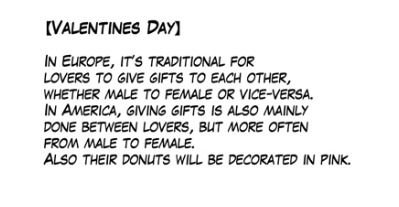
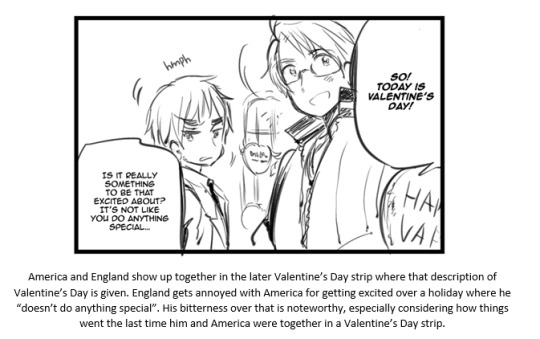
The next strip is also really explicit in expressing England’s attraction towards America. This is a scene from the 2011 April Fools Day Event.

Not much to add on here. America was blackmailed into wearing a very provocative outfit. England responded by awkwardly complimenting him. Judging by the motion lines next to his outstretched arm and America pulling back, he might also be grabbing at the apron.
The last strip I’ll go into is “The Long-Deep Awaited Emotion is Ruined”. Explaining jokes aren’t fun, but it’s necessary here. Near-death love confessions are a very common trope. This scene initially seems to be playing that trope straight, England starts by admitting he doesn’t hate America. He then tries to say something else, something that seems much more significant. The build-up is there, but England is cut off before America can hear him out to the end. Then comes the subversion of expectations which are the heart of the joke. Instead of being upset, America celebrates England’s death knowing it’ll wake him back up. All the tension that was previously there is instantly gone.

This scene was absolutely meant to be an attempted love confession. All the build-up matches that of a love confession. Death swooping in to shut England up before he can say anything that’ll shake up the status quo of the series matches up with a love confession. The entire joke is that it looks like a classic death bed love confession up until expectations are deliberately subverted. Romance isn’t at the forefront of their relationship or anywhere near it for that matter. But England has had moments where he’s made it clear his feelings go beyond their usual platonic interactions. If he thinks America is initiating something romantic with him (Buon San Valentino), he’s ready to reciprocate. If America is in a revealing outfit (April Fools Day 2011), England is probably taking in the view. And if England has nothing else to lose (The Long-Awaited Deep Emotion is Ruined), he’s going to at least try to tell America what his real feelings are - even though maintaining the status quo of the series won’t let him. Aside from these moments, since he’s often not willing to be honest in what he wants, these feelings are a large part of why he swings back and forth between constantly antagonizing America and showing his softer side in hopes of becoming closer to him.
America’s Ambiguous Feelings
Now that I’ve laid out the evidence showing that England is attracted to America, it’s time to go into America’s perspective. Or, in the context of romance and England, his lack of a given perspective. To an extent, America’s behavior parallels England’s. Instead of being overly critical and grumpy towards England, he teases him. He makes comments towards him that will get him riled up, prank calls him, and comes up with schemes to get him to do what he wants -even if those schemes get England angry- instead of being more honest with him.
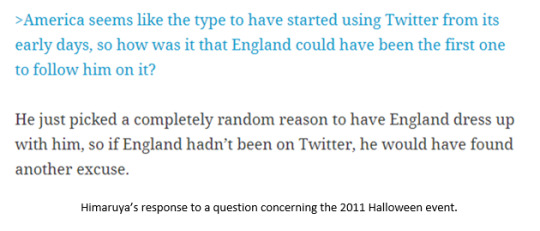
Also like England, he clearly cares for the other. And he cares a lot. He chose England above everyone else to pair up with for his Halloween costume contest, England was listed as one of only two friends of his in an early character description of America, and as much as he complains about having to help England home when he’s drunk, he still does it.
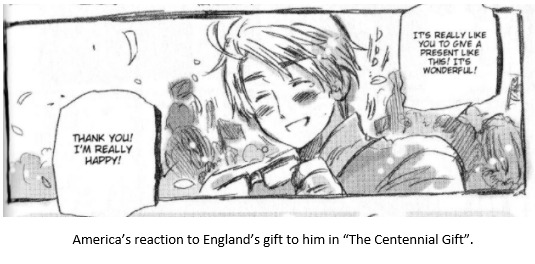
Here’s where a major difference is. Not only is America comparatively lacking in moments where he completely drops the teasing in order to be honest with his feelings, he’ll deflate emotionally heavy moments that England initiates. If England is ready to open up about his feelings, America is ready to shoot him down and laugh things off. A few examples include America shooting down England’s friendship offer, responding to England’s complaints of being cold with “I won’t do anything for you”, pretending to be happy about England dying so he’d wake back up. This combines with how his usual tactless behavior is used to obfuscate his actual feelings like what happened with the costume contest.

Bringing this all back around to the romance part of their relationship, it’s hard to tell where America stands. There’s not really any concrete evidence that he likes England back and he doesn’t engage with England’s more forward moments.
There is some evidence he might not think of England as attractive.

When France brought him to a cafe, one that he didn’t give America any details on, he seemed uncomfortable. He also didn’t seem to appreciate the pass England made at him in the 2011 April Fools Day event. However, in both of these situations, it’s more likely that it was the revealing outfits making him uncomfortable and not that it was England involved in those situations.

The one thing that can be concluded is that he’s aware of England’s feelings. Running back through the strips brought up with England, there’s evidence of that much. He didn’t react all that much to England making a pass at him in his waiter outfit. The comment he made didn’t seem to surprise America at all. It just made an already uncomfortable situation more uncomfortable. He also didn’t seem curious as to what England was trying to say before he was cut off by the Grim Reaper which implies he’s already well aware of where England was going. Once England was back up, he didn’t push the subject at all. And him knowing makes sense. America is not as oblivious as he often acts, as shown in his interaction with Canada brought up earlier where he privately acknowledged Canada’s feelings and that, to a lot of people, his own personality makes him difficult to get along with. He’s very much capable of reading the atmosphere and picking up on the feelings of others even if his behavior doesn’t always reflect that.

There are various plausible interpretations over why America has never directly acknowledged England’s feelings. Maybe he doesn’t feel the same and doesn’t want to hurt his feelings. Maybe he reciprocates, but something else is holding him back from doing anything about it like not feeling ready for a relationship. Whatever his reasoning is, anything I could come up with would just be an interpretation and nothing that can be concretely proven.
That’s the non meta way of seeing America’s perspective anyway.
Why UsUk (Or Any Other Ship) Probably Won’t be Canonized
Let’s take a moment to focus on Hungary. In a series with a by far mostly male cast, Hungary was the first female character and she remains as likely the most popular female character from the series. It’s a status matching the panel time, development given to her, and how long she’s been a part of the series. And there’s a trait that she, again the first major female character, was given.
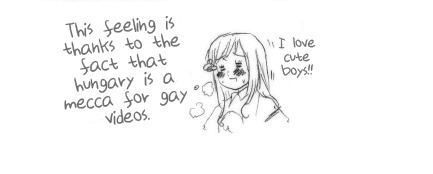
Hungary really likes cute boys. Not just cute boys as individuals, but cute boys being sexually involved with each other as well. So much so, that she was willing to wait out France assaulting Austria for a bit so she could watch. Hungary is meant to be an audience surrogate in this way. She’s a fujoshi. Hetalia doesn’t really qualify as a BL manga, but it definitely falls into the category of manga that focuses on a mostly male cast, has a lot of fanservice, and there is a lot of potential for romance when it comes to several of the male-male relationships. This is something Hima is very conscious of. The series is not at all lacking in opportunities to see the male cast undressed and there’s even a strip where he recommends “My Neighbor Yaoi-Chan” to readers. Whether or not he’s familiar with the BL genre, he definitely seems to be familiar with its audience.

So maybe this might make the conclusion in the title of this section seem wrong. If Hima is knowingly doing things that appeal to people into BL and the category of manga previously mentioned, then wouldn’t it make sense that it’s likely UsUk and/or another ship could be canonized? Actually, no. The interactions between America and England aren’t meant to seriously build up to a relationship upgrade, they’re supposed to show that the potential exists. The way this is often done in other works is by being really heavy with subtext without any confirmations, but Himaruya seems to have a trend of confirming things on one side of a relationship, but never having the other side respond to those feelings or even acknowledge them. This is not just true for UsUk. It’s true for GerIta and SuFin as well. The former even has an unresolved potential childhood love backstory (something that fans are no closer to getting closure on over ten years after Buon San Valentino was made) while the latter had Sweden’s feelings for Finland directly confirmed by Himaruya. There’s an importance to never crossing the line into relationship territory and that importance is that it would take control out of the hands of fans. The more obvious way in which this would happen is not everybody would like the pairings he’d go with and are instead invested in other pairings involving the same characters. It’s likely that many fans would even drop the series over this depending on how invested they are in shipping. The other reason involves the shippers of the canonized pairing. People who ship a certain don’t necessarily have the same vision for what a relationship between the characters would look like and some fans get very invested in their specific take. By not canonizing any pairings, fans can iron out the details themselves instead of potentially being disappointed. Contrary to what one’s intuition might be on appeasing this kind of audience, lesser is better.
Back to UsUk specifically, it’s not that America’s behavior couldn’t be explained with in character reasoning. It absolutely could. But that lack of response exists within a broader pattern of teasing relationships that never go anywhere. This is something I’d love for Himaruya to prove me wrong on when/if he returns from his hiatus. But unless that surprising turn of events happens, this is why UsUk (or any other ship) won’t be canon.
I’ll end this section with this picture.

Here, you can see that England is using part of America’s uniform as a pillow, a clearly intimate gesture. We know England wanted to use the uniform. He wouldn’t have it if he didn’t. But how did he end up with it? Did America give it to him? Did he toss it to the side and England took it? This question, where America’s feelings are relevant, isn’t something Himaruya is going to answer. Fans are left to come up with their own answer, the answer that makes them the happiest.
Conclusion
There’s enough evidence within the text to conclude England has romantic feelings for America. Buon San Valentino confirmed that much and there are other moments to back that up coupled with a fixation on America that manifests in a mix of grumpy, over-the-top critical behavior and vulnerable, openly affection-craving behavior. America, on the other hand, is more ambiguous. He parallels England in some ways in that he clearly wants the other’s attention, but usually doesn’t go about it in the most honest way. But unlike England, there’s no concrete evidence showing romantic feelings on his part. Even though England has feelings for America, those feelings are unlikely to ever be fully acknowledged in the text itself. The way the series goes about romantic relationships is by indicating there are romantic feelings on one side, opening up the possibility for a relationship but never actually delivering anything beyond the possibility. This makes it unlikely the two will ever get into a relationship.
216 notes
·
View notes
Text
Michael Myers in John Carpenter’s Halloween (1978) - Part 2
I personally think that John Carpenter’s Halloween in general puts most of the later entries to the franchise to shame for one reason or another, but mostly in regards to Michael Myers as a character and the way he’s both portrayed as well as utilised throughout the movie.
(That’s not to say no other movie has done the character justice. I enjoy most of Michael’s iterations throughout the franchise, though admittedly some more as a guilty pleasure and others only to simp for rather than because they’re genuinely good portrayals.)
1. Michael’s presence throughout this movie is constant - yet we don’t actually get a good, close-up look at the mask until very late in the movie
For most of the movie we get to see Michael from one of two “perspectives”: we stalk his victims with him from behind his shoulder (I talked more about this in my post about the voyeuristic subtext of Halloween 1978) or we see him standing somewhere off in the distance. Especially the stalking scenes persist throughout almost the entire runtime of the movie, the last one occuring at around 57 minutes when he watches Linda and Bob make out on the couch.

And yes, technically we can see the mask while he stalks Laurie around Haddonfield, but with the distance between him and the camera and the short length of those scenes it’s hard to really look at it, especially if you watch the movie for the first time and aren’t on, like, the 20th rewatch in the span of a month - not that I’d ever do something like that, of course...

As for when we finally get to see a close-up of the mask, I guess you could argue for one of three moments: Michael killing Annie in the car, Michael about to pin Bob to the wall or Michael picking up the phone after he strangled Linda. I personally would argue for the last, as the camera hovers outside the car in the scene with Annie, our view blurred through the windshield, and the mask is half-hidden in shadow when he kills Bob. All of these scenes happen rather late in the movie, the earliest - Michael killing Annie - more than 50 minutes into the ~1:30hr runtime.

2. The movie manages to make Michael creepy without having any actual on-screen gore
It’s the suggestion that scares us, the unnerving physical vocabulary established by Nick Castle, the way he lurks in the shadows or stands outside in broad daylight, slowly closing in on his mostly unsuspecting victims.

We don’t need to constantly see Michael kill to be afraid of him (or simp for him...) here, it’s the anticipation of when he’s finally going to do it, the payoff of tension when he finally does.
The kills are shot in a way that don’t need shocking gore-filled imagery to be terrifying and poignant; with Michael choking all of his victims in some way and his vocalizations throughout they have a fascinating but horrifying sexual subtext to them that many of the later sequels sadly never returned to.
3. Michael as an ambiguous character
With enough scenes to support either a connection to the supernatural or a strictly human Michael - or both - this movie leaves the interpretation of his character mostly to the viewer. We can believe Loomis’ monologues about Michael being simply evil, not at all a man - yet Michael displays many small quirks and shows behavior that directly disprove this as well.
Michael
accidentally walks into the flower pot in front of the door when he spies on an undressed Annie
tilts his head at her in the background after she gets locked into the laundry room
tilts his head after killing Bob
dresses up as a ghost
sets up the ‘haunted house’ for Laurie
... and those are just the most obvious instances of him showing behavior that doesn’t fit the description of a consciousless, purely-driven-to-kill force of evil. (I’m probably going to come back to this topic in more detail at some point.)
It’s the small things like him stopping for a second when he notices Tommy after he grabs the wrong kid that make this portrayal so fascinating to me, those clear hints that there is a (evil, psychopathic, dangerous) human being beneath that mask, despite what Loomis tells us.

With ambiguity I don’t only mean the “is or isn’t he supernatural”-debate, I also mean the question behind Michael’s motives or the lack of them, what his reasons for killing are. Take for example Halloween 2: it wants you to believe that Michael hunts Laurie because she’s his sister, which is not only much less interesting but also written really badly. This is a pitfall many of the sequels fall into for me personally; I feel like trying to explain Michael just isn’t a concept you can ever get to work in a satisfying way.
4. The un-masking scene
I could probably rant for days about the last 20 minutes of the movie, but I’m gonna keep it simple here: casting Tony Moran for the unmasking scene was a stroke of genius. It plays into an aspect that I feel sets the original Michael apart from many other slashers: there’s nothing obviously wrong with him. He looks unassuming, even handsome.
Add to that the contrast between his inhuman strength and his normal physical build as well as his way of moving throughout the rest of the movie (graceful, but also unnaturally still, unnerving to look at without steering into zombie-like or otherwise inhuman territory) - all of it proves him to be human without actually humanizing him too much.

It’s a shame that most of the sequels didn’t try to do anything like this again (I know the Halloween 5 unmasking scene exists but I honestly wish it didn’t, so lets not talk about that here) - I’m very happy they went back to the concept of showing Michael both with as well as without the mask in Halloween 2018.
5. And finally - the end of the movie!
This is very biased as I’m a total sucker for open-ended movies, as long as they don’t leave any critical questions unanswered. But I think this also applies at least somewhat objectively to the Halloween franchise: most of the endings that had Michael die got retconned sooner or later anyway, most of them not in a very convincing way.
The movie’s last moments with Michael breathing in the background while we revisit the locations we saw throughout the movie hammers home the thought that he could be everywhere and that nothing can stop him, and that - to me - is a very poignant and satisfying scene to end the movie on.
#halloween 1978#halloween#john carpenter's halloween#john carpenter#michael myers#the shape#halloween franchise#horror#horror movie#slasher#slasher movie#halloween1978#more undercover simping#is it even remotely undercover at this point though#analyzing this movie to get something productive out of my unhealthy amount of rewatches
92 notes
·
View notes
Text
The Worldbuilding Diaries- Chapter seven; How to establish culture in your work

Image taken from- www.fgukmagazine.com
Fantasy cultures can veer on the side of absenteeism in a story or feel deeply understood and grounded in fantastical realism. When I transitioned from my main characters' perspective in my WIP, The Sun Ballad, to my secondary point-of-view character I entered a completely new world with an equally diverse culture I was bound to unearth. I found myself describing lavish rooms decorated with hand-woven tapestries, trays laden with sweetened milk and manuka chocolate trying to contrast the two perspectives of my characters with their environments.
It's easy when drafting a culture to simply write what feels right for the scene, describing clothing, dance, music and culture to better emulate a feeling or surroundings as opposed to conveying a culture. Implementing cultural concepts should emulate your own cultural design and feel niche in it's design.
This post will cover:
-Creating a distinct and realistic feeling culture
-How to contrast cultures

When creating a culture it's important to communicate a sense of unity in its design, these are a group of people with similar ideas who have not yet grown apart or diversified, although there must be a common ground, a common goal. For example, in the freezing arctic, it might be difficult to convince settlers that fasting is the best way to devote one's self to their chosen god. It's important to think about what percentage of a persons life can be dedicated to supporting a cultural evolution, In a place where life is hard and food is scarce there might not be as much time to whittle wood into little figures of gods or paint elaborate tapestries to gift the new king. Places that are prosperous and established can afford to put energy toward storytelling, arts and culture and people can turn these cultural arts into occupations and live their lives depending and developing it.
Start from the ground, the region, the ideas, the religion and begin working up if your god survived a fight by being protected from encroaching fire, settlers might vouch for modesty and punctuality, with armour on always. Build on, how might rulers and preachers control the populous? With story tales, ideas, threats, warnings on how the gods punish wrong-doers, are defenders of the law dressed in distinctive clothes or are they secretive in their duties taking on the role of spies instead of soldiers. What is enlightenment to these people, what is luxury, what is the worst crime someone can commit and how do they protect themselves from it?
Asking these questions allow you to think deeper on how culture originates, remember there is a reason why we tell stories, why we make things up and add value to shiny rocks and formulate a hierarchy within our groups it's because we're social animals, pack animals at heart. Acceptance and happiness is desired and culture is what is acceptable and what brings one happiness.

Around a laden table, people tell stories of the gods, of hunts and of heroes and villains, they feast on the favoured dishes of the area. What are these foods, if your people live around open seas and little rivers they may eat more fish, crustaceans and shore dwelling plants. If the region is surrounded by thick mountains, mountain lion meat and goat milk might be on the table. I've found that creating a list of all the foods fantastical or not, meat and vegetarian on a list to reference whenever my characters are eating, if they are feasting the delicacies come out. This way the food my characters can access in each region stays consistent and helps cement the culture of the region and its people.
It may also be interesting to explore how do different cultures in your story interact with food, is it something to be respected and treated with care should no one touch another's plate while they are eating, are religious figures required to bless every meal. Research how different cultures interact with their food, is it purely animalistic or inventive in design. How is the food presented and what table manners are vouched for?
People interact with food differently and how a culture or group of people eat can say a lot about their home region and culture.

From headresses to full-length ball gowns, information on your cultures treatment of modesty and accesability of decorative metals can help with a cultures memorability and impact in descriptive scenes. Clothing can be directly tied to a religion or wholly separated, certain characters or groups can be recognizable by a piece of unique attire or emblem. Remember you can also communicate classes through clothing, there will always be a simpler, mass-produced piece of cultural attire common amongst most of the masses. Diversity in cultural clothing is often the result of most of the populace trying to save some of their money and make life easier for them, painted on flowers as opposed to embroidered one, weaving old fabric into new to create a checkered pattern. Do not overlook heirlooms, keepsakes and smaller attire like jewellery and coin purses, clothing tells a story look to your own and see how much it tells you, the colours you like, cuts and fabrics most accesable to you, favoured animals or cuts.
Contrasting Cultures
All of these features and ideas to explore are enhanced when used to compare and contrast two cultures, what are the differences and how do they impact communication and collaboration between two groups. If one group respect and worship deer and another routinly eat it a relationship between the two groups might struggle to form and will likely fail to be established. Always note the impact of a cultural idea or development on others in the surrounding area and take advantage of these differences and dillemas afterall we fear what we do not understand and misunderstandings or mistranslations from one culture to another can create an interesting ripple-effect.
Cementing your characters cultures and worldview is paramount to crafting an interesting and believable world that strays far from our own, never underestimate the power of consistency and clarity.
-E
#worldbuildingdiaries#wbd#amwriting#writingadvice#fantasy#novel#nanowrimo#fantasyseries#worldbuilding#writeblr#worldcraft#charactercreation
29 notes
·
View notes
Note
More on Si irritation with Ni: I want to see if I’m following. (I deal with lots of Si users so I figure I should learn better how to relate to them). It sounds like Ni users leave you thinking, “Okay, that’s nice,” or irritated and resistant when the Ni starts to push their perspective onto you. It seems like the main issue is you can’t see what they see nor does their articulation of it to you lead to you seeing it, with the irritation coming in when they try to push their views onto you.
2/Here’s maybe a pair of useful examples. Sun Tzu, “Art of War,” is full of maxims presented as definitive truth, with almost no concrete examples. Chapter X, “Terrain,” “We may distinguish six kinds of terrain, to wit: (1) Accessible ground; (2) entangling ground; (3) temporizing ground; (4) narrow passes; (5) precipitous heights; (6) positions at a great distance from the enemy. Ground which can be freely traversed by both sides is called accessible. With regard to ground of this nature, be
3/ before the enemy in occupying the raised and sunny spots, and carefully guard your line of supplies. Then you will be able to fight with advantage. Ground which can be abandoned but is hard to re-occupy is called entangling.” Etc. Why does Sun Tzu think this exactly? He says, “These six are the principles connected with Earth.” What set of facts led to the belief that these are true statements? We don’t know. An Si account would contain a historical example that led to the conclusion
4/ Contrast people thought to be Ne-dominant Si users like Che Guevara’s “Guerilla Warfare.” Che says there are “general laws that hold for all fighting of this type,” but almost all of his discussion is contextual and about what worked in his own experience. In writing a section on “Warfare on Favorable Ground,” which sounds like it’s going to contain a general discussion about terrain like Sun Tzu’s, Che wrote, “The arms preferable for this type of warfare are long-range weapons requiring 5/ ground, affording a greater margin of security for the weapon and its personnel, but they ought always to be a means of repelling an enemy and not for attack. . . 10 to 15 single-shot rifles and about 10 automatic arms between Garands and hand machine guns, including light and easily portable automatic arms, such as the Browning" Isn't this discussion wildly specific for a chapter that is supposed to be about a general topic? But the detail is there to follow the conclusion.
--------------------------------------

I should state: am not mad. I honestly think this is absolutely hilarious, and without even reading the excerpts from military theory here I can tell you right away that if you are a high Ni user and you think the high Si users around you are irritated...you are probably correct, because I'm pretty sure you just took five entire paragraphs and two wholly gratuitous references to say "So it sounds like Si wants historical perspective for things [note: not universally true] as well as detail [true], and Ni users may not [also true].
Anyway if you're irritating to Si users, they're not mad at you because you're an Ni user, they're annoyed because you could probably say what you just said here in a small fraction the time and it would be infinitely more effective. Honestly if you are like this all the time in person...look, I mean this gently, and again, because this is over text and I'm voluntarily responding I am not at all annoyed, but anyway if you're like this in person, probably more than just the high Si users are annoyed. If you are looking for advice, I would advise getting to the point and also saving the pretense for when you want to intimidate people.
(I would add: I actually completely disagree with the Sun Tzu example as being about Ni or Si and would be more of a Ti vs. Te example with Sun Tzu being more accessible to Te; it's been a while since I read The Art of War but it's fairly strategic, and the desire to need an entire detailed explanation of everything is more of a Ti impulse than Si. Meanwhile, Guerilla Warfare is written by someone you've said is a high Ne user but you're using it as evidence for high Si, which, no offense, a rookie mistake and why so many people are so bad at understanding Si, because descriptions of Si are often based on people with Si in the tert or inferior positions.
All that aside I just think your argument is mostly unmoored from context, which is to say The Art of War was written in ancient China and Guerilla Warfare was written in 1960s Cuba. Those are wildly different cultures, and a lot of the differences and stylistic choices need to be understood with that in mind; I'm not sure if you're just using them as analogies for MBTI functions or if you think the authors have Ni and (low) Si respectively but either way I don't think they're good examples in the first place.)
8 notes
·
View notes